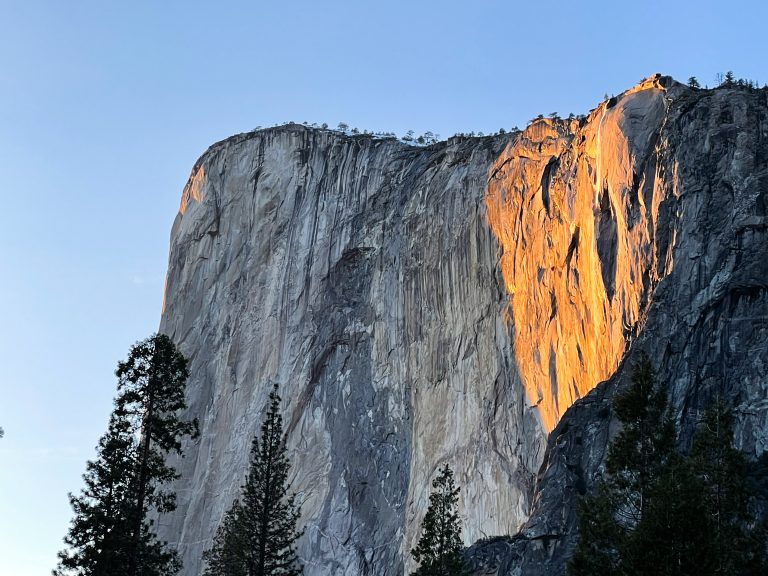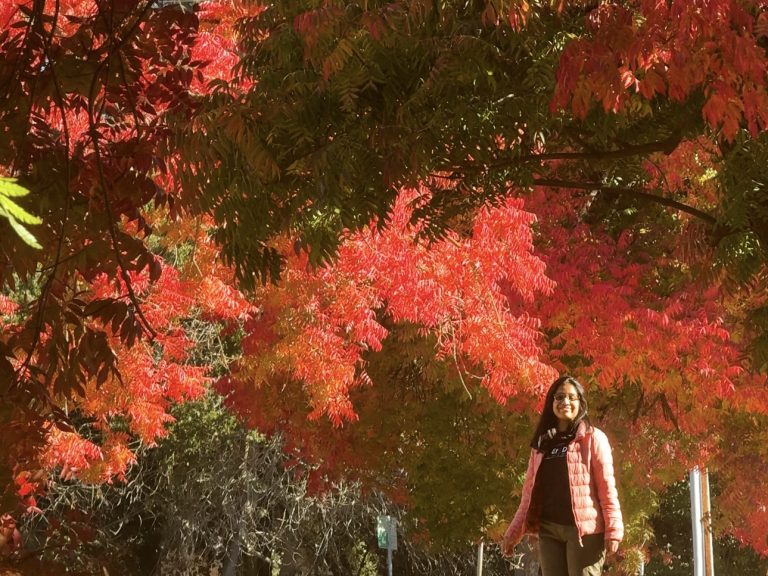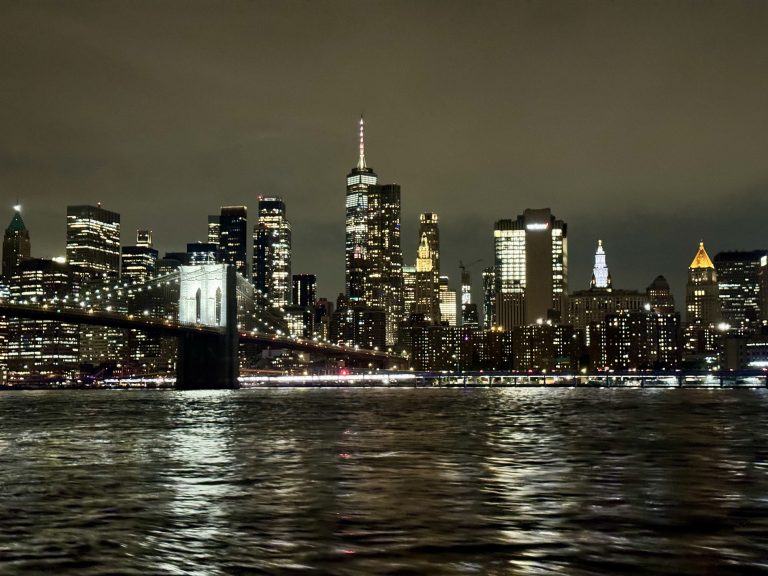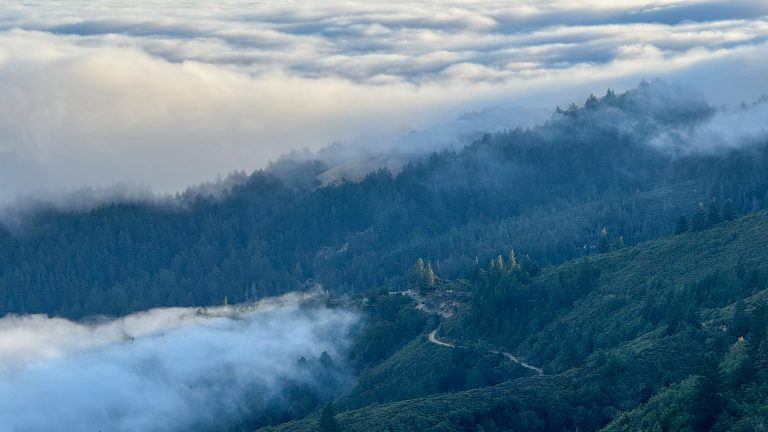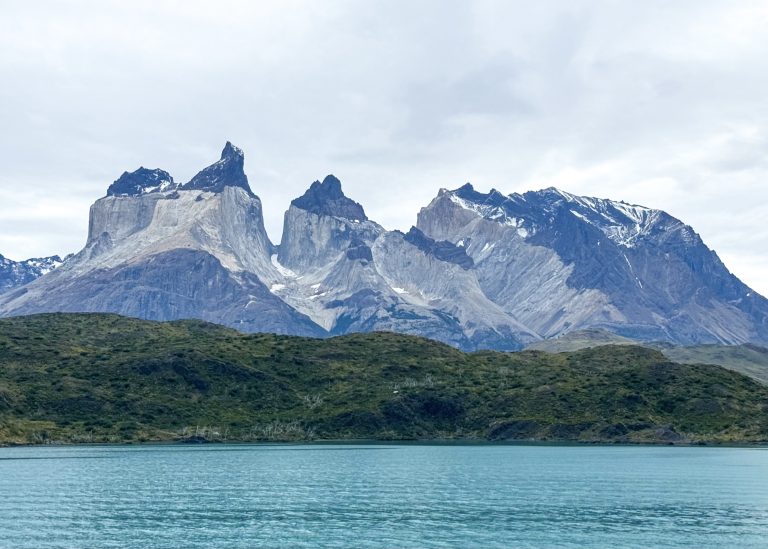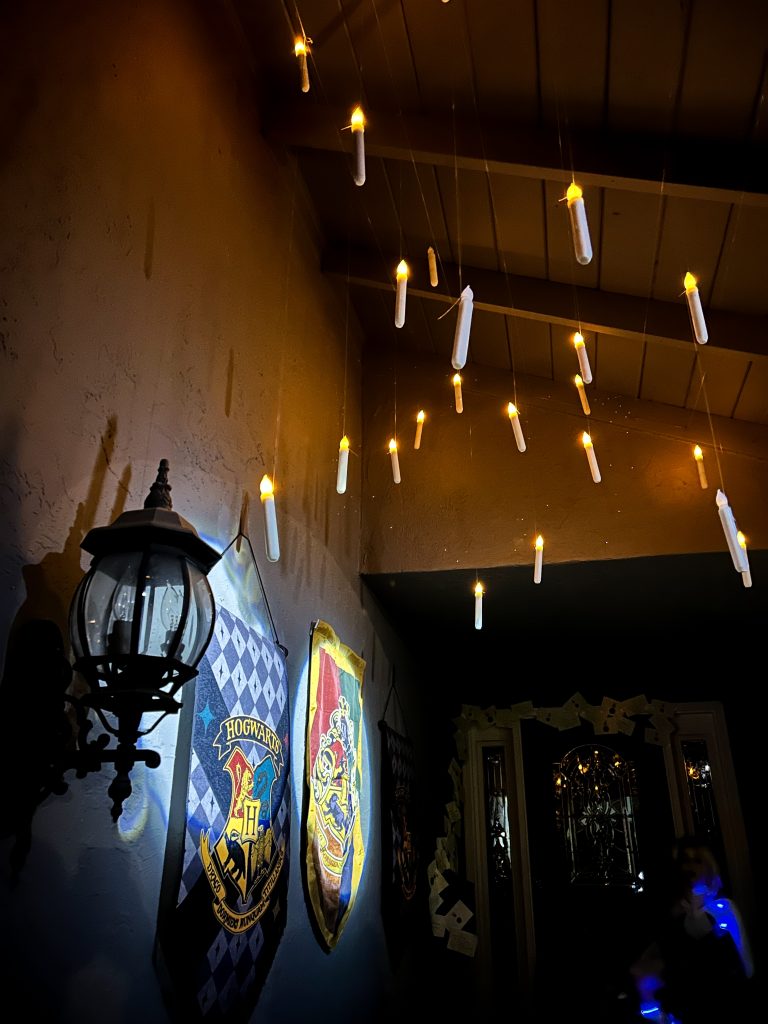The Best California Road Trip – 3 Day Itinerary to explore the Eastern Sierras
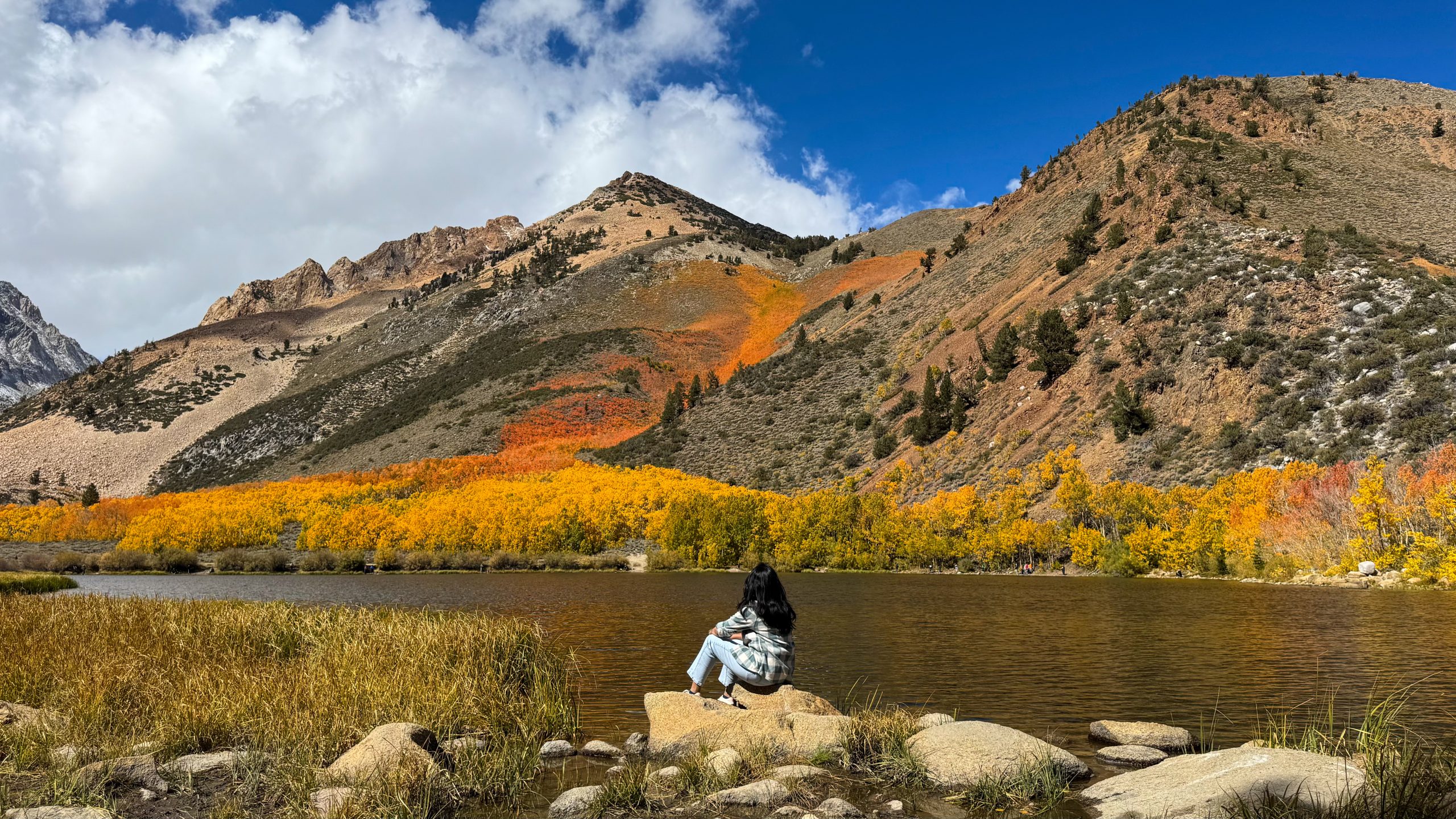
We’ve been to the Eastern Sierras a bunch of times now — in summer, fall, and everything in between — and every trip feels like discovering something new. After a few rounds of trial and error, I think we’ve finally perfected the itinerary for this epic California road trip! We even followed this exact route on our recent trip with our parents, and they loved it just as much as we did. It’s got a little bit of everything — epic views, hidden hot springs, a touch of history, and that wild, untamed Sierra magic.
Not many people make it past Yosemite to the east, and honestly, that’s part of what makes it so special. Sure, it’s a bit of a drive from both the Bay Area and LA, but once you’re here, you’ll see why it’s worth every mile.
The Eastern Sierras are rugged, raw, and unlike anywhere else in California — think alpine lakes, high desert plains, and dirt roads that lead to some of the most jaw-dropping scenery you’ve ever seen. Don’t cancel me for saying this… but I think it’s even better than Yosemite.
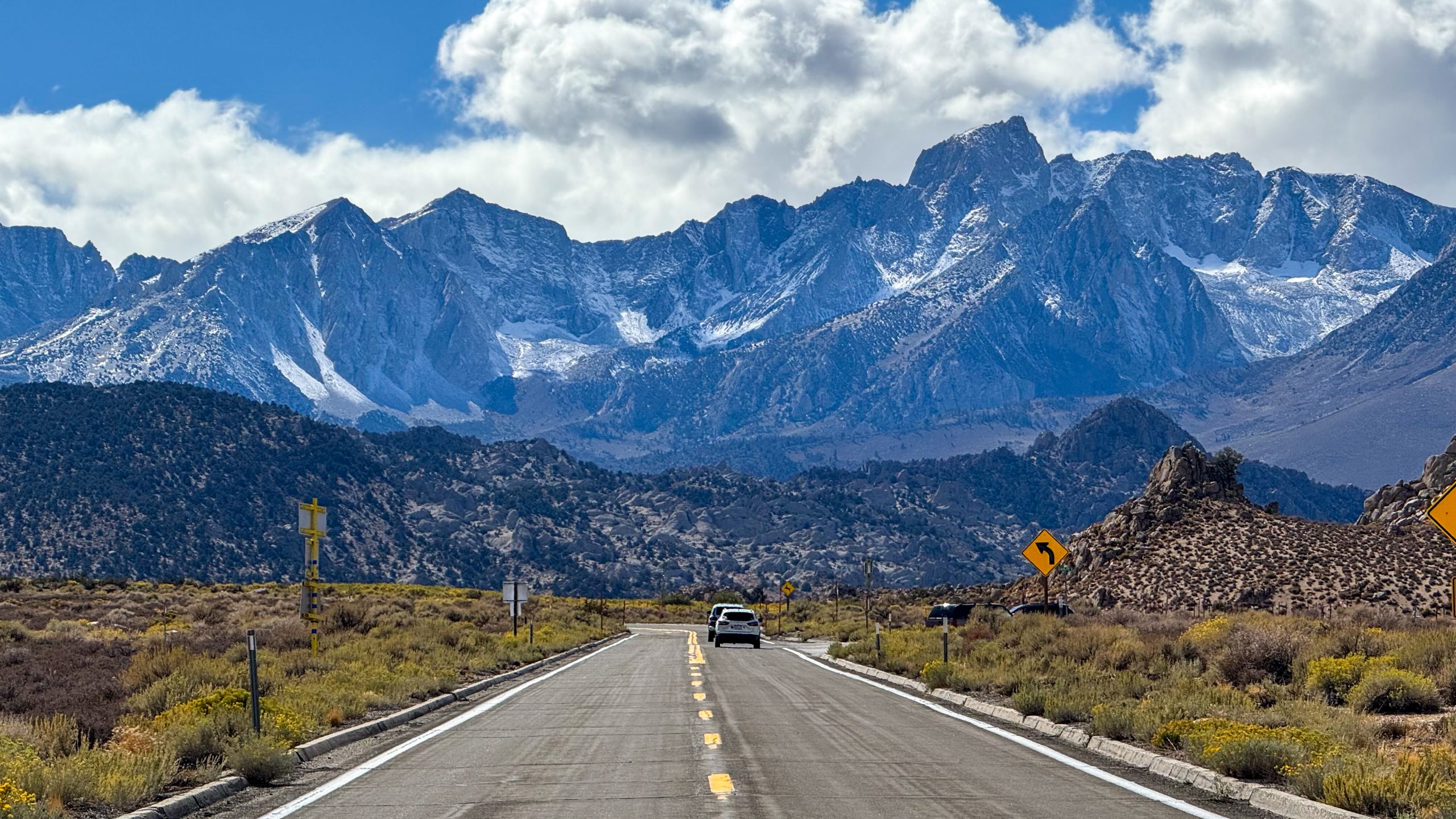
Where are the Eastern Sierras?
The Eastern Sierras stretch along the eastern side of California’s Sierra Nevada mountain range, running roughly from Bridgeport and Mono Lake in the north down to Lone Pine and Mount Whitney in the south. Highway 395 is the main road that ties it all together and will be the heart of this California road trip.
If you’ve ever driven through Yosemite’s Tioga Pass (Highway 120), that road actually drops you right into the northern part of the Eastern Sierras near Lee Vining. So while it’s often described as being “past Yosemite,” it’s really a whole stretch of wilderness that runs alongside the Sierra Nevada.
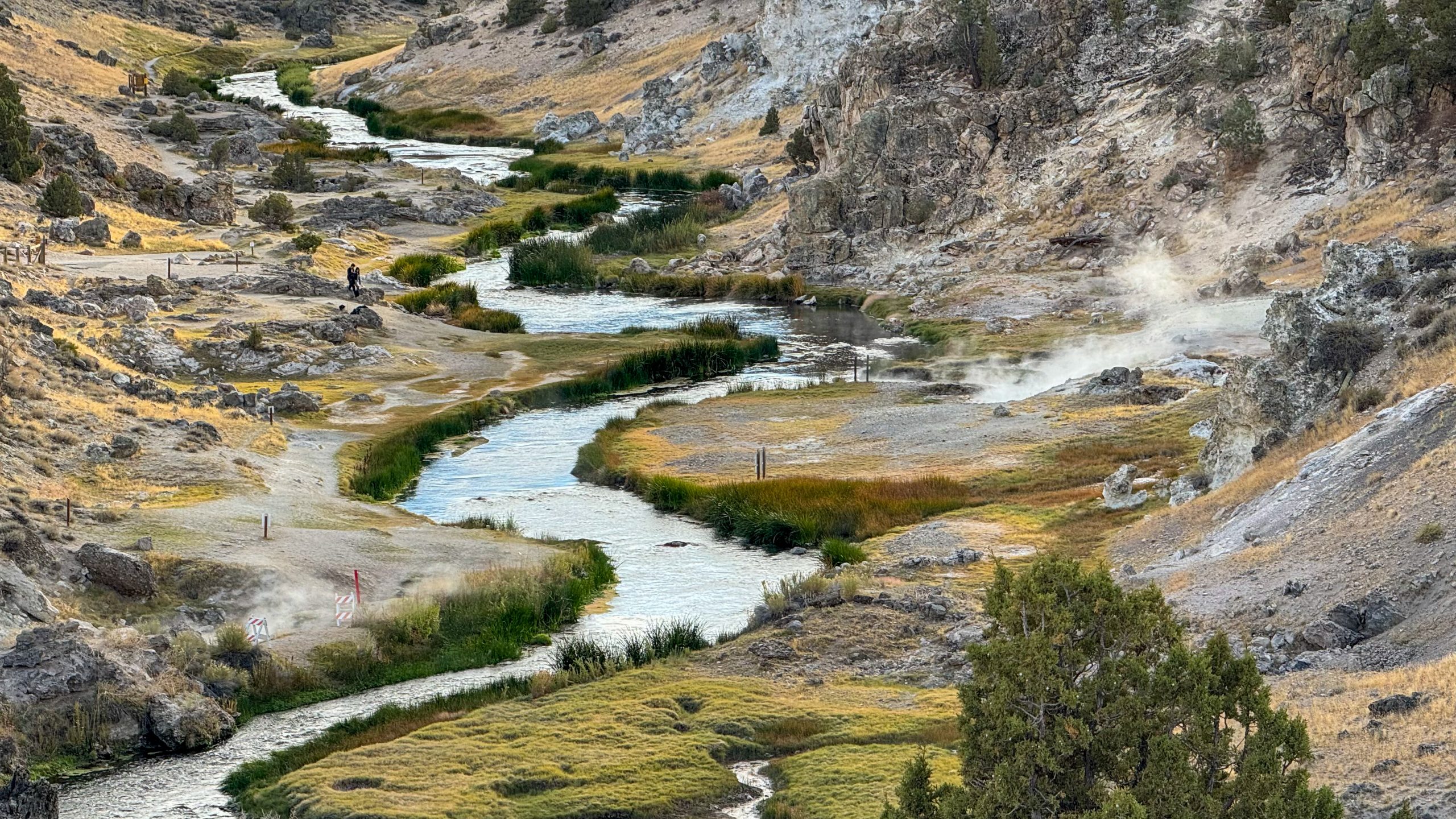
How to get to the Eastern Sierras?
The most convenient (and budget-friendly) way to explore the Eastern Sierras is by car. From the Bay Area, it’s about 6 hours, depending on your route and stops. From Los Angeles, plan for around 5 hours.
Tip: If you can, rent or bring a 4WD vehicle. You’re going to need it! Some of the most beautiful spots out here are tucked away down dirt roads, and having a sturdier car makes exploring a lot easier (and safer). If you’re visiting in fall or winter, it’s especially worth it — Eastern Sierra weather can change in a heartbeat, and a 4WD will handle it like a pro.
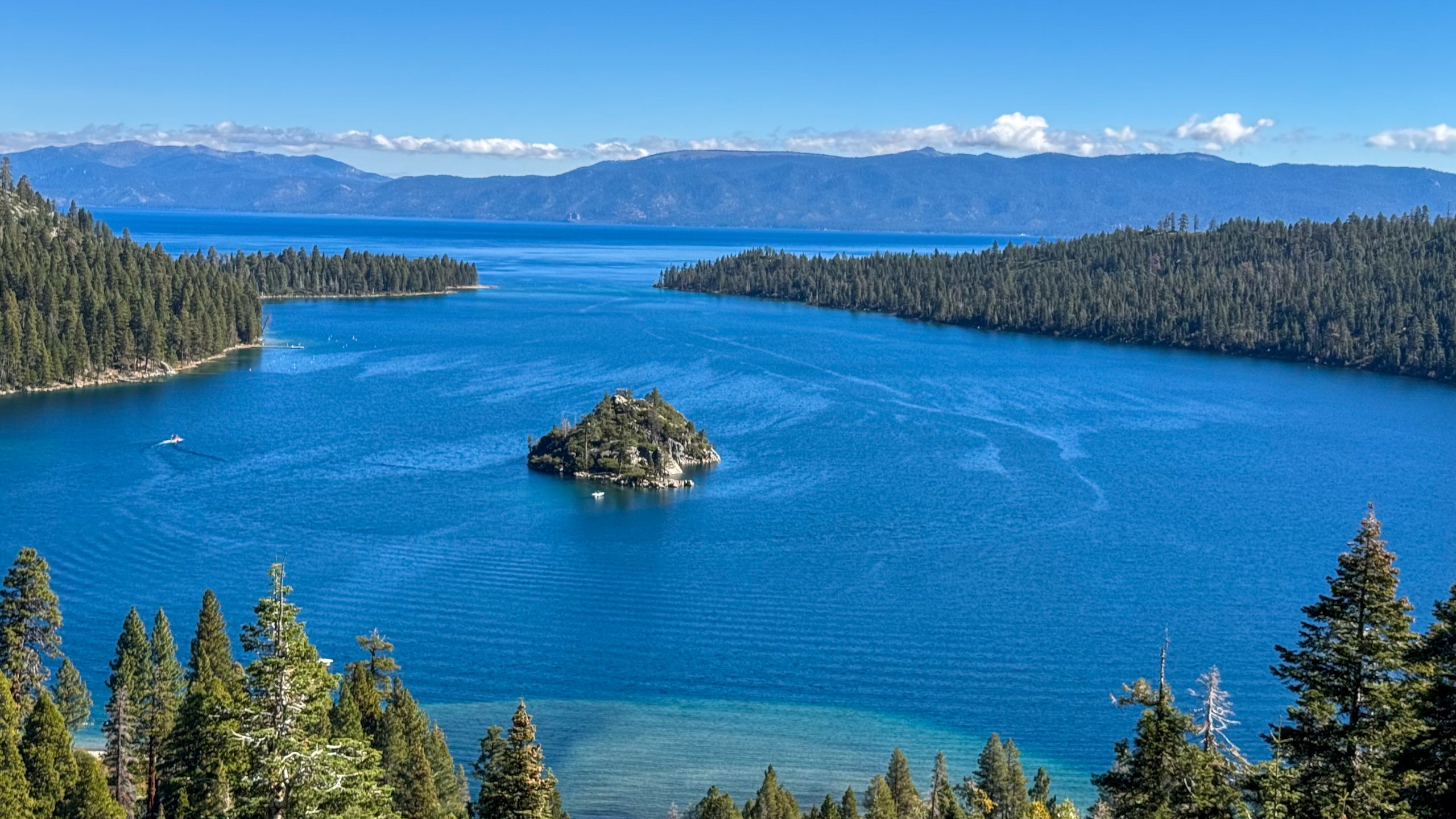
When is the best time for a California road trip through the Eastern Sierras?
Honestly, there’s no bad time to visit the Eastern Sierras — it’s beautiful year-round. Every season has its own kind of magic, and the landscape somehow feels completely different each time you go.
If you’re into hiking or backpacking, summer is your season. The trails are clear, alpine lakes are warm enough for a quick dip, and mountain passes like Tioga are open.
Winter turns the whole region into a snow globe — Mammoth is buzzing with skiers, and those snow-capped peaks are just unreal. Plus, soaking in a wild hot spring while it’s snowing around you is an absolute bliss.
Spring is when everything wakes up again — waterfalls are gushing, wildflowers are everywhere, and the crowds are still pretty mellow.
But my personal favorite – Fall, hands down. The Eastern Sierras have the best fall colors in California. If you time your trip right, you’ll catch golden aspens and fiery orange trees glowing against deep blue lakes. It’s the kind of view that makes you pull over every five minutes just to stare.
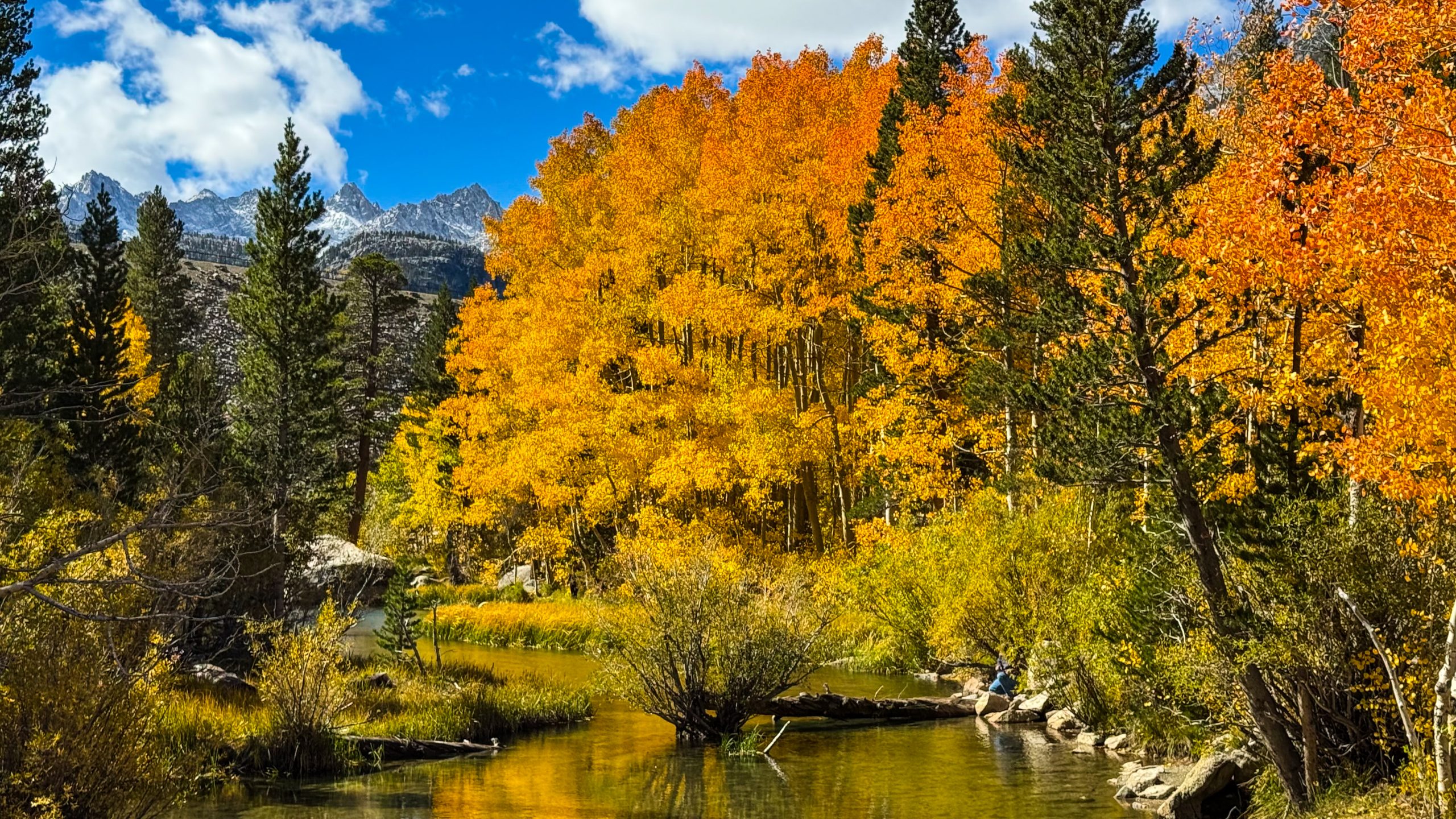
How to catch peak fall colors in the Eastern Sierras?
If you’re planning a fall road trip, timing is everything. The colors here don’t last long, and if you visit too early or too late, you might miss those picture-perfect golden aspens. Go too late, and you’ll find bare branches where the color once was — still beautiful, but not quite the same magic.
Fall in the Eastern Sierras moves from high elevation to low. The leaves start changing around the alpine lakes in late September, then gradually work their way down to the valleys and towns through October — sometimes even into early November, depending on the weather.
So, if you’re visiting early in the season, plan to spend more time around the higher elevations — places like North Lake, Sabrina Lake, or Rock Creek. If you’re visiting later, focus on lower elevations like Bishop, June Lake, or the areas around the Owens Valley.
To make sure you don’t miss the show, here are two great resources I always check before planning a trip:
- California Fall Color Map – This map (usually updated weekly during the season) shows which regions are peaking across California. It’s a handy way to see where the color is moving and plan your route accordingly.
- Bishop Fall Color Reports – The town of Bishop posts regular updates on their website and social media throughout fall. They share detailed, first-hand info on which lakes, canyons, and valleys are showing the best colors that week — super helpful for fine-tuning your itinerary on the go.
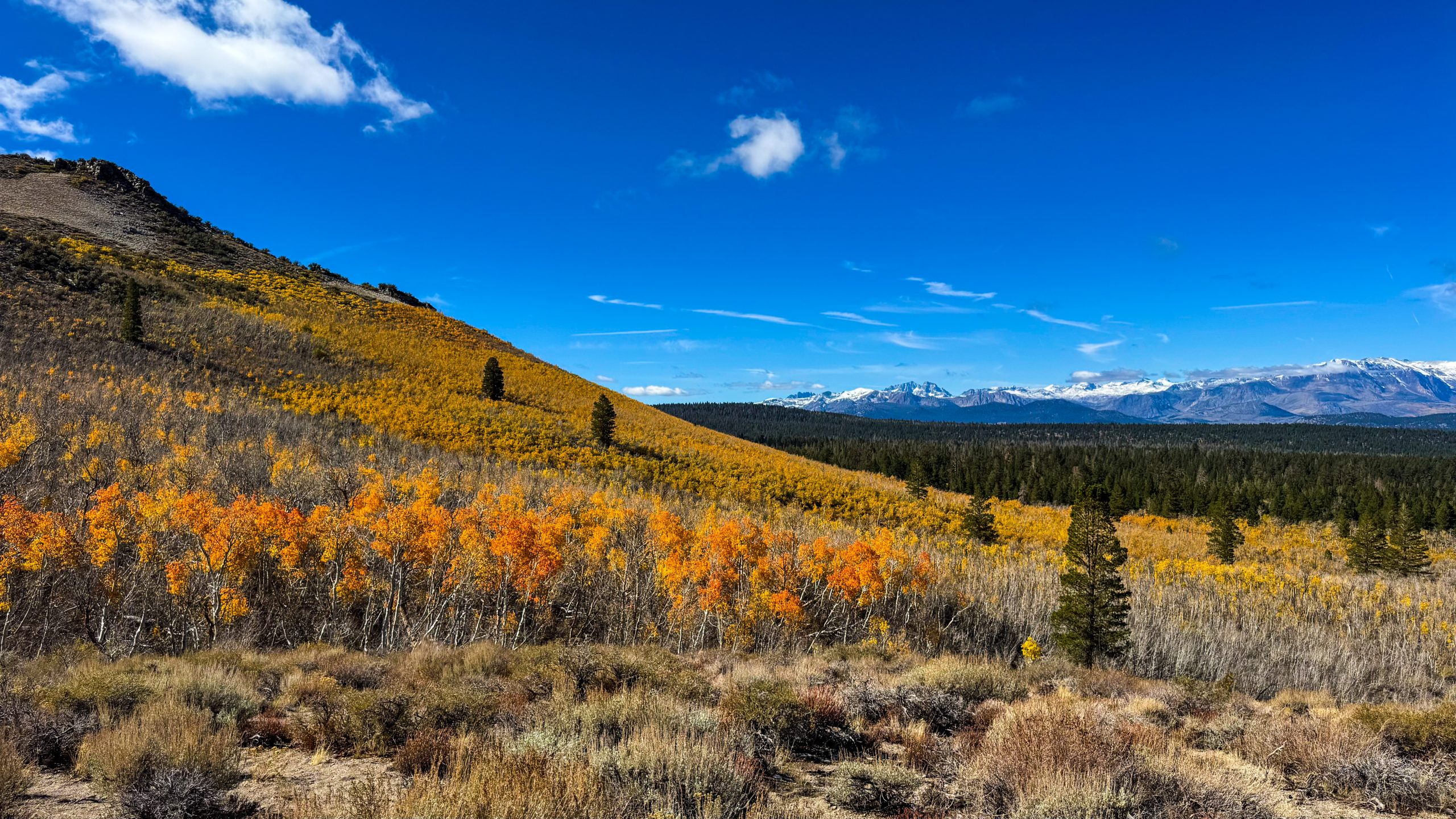
Where to stay on your trip to the Eastern Sierras
One of the best parts about this California road trip through the Eastern Sierras is that you’ll pass through a handful of cute mountain towns — each with its own vibe and charm. Some great places to base yourself are June Lake, Mammoth Lakes, Bishop, Bridgeport, and South Lake Tahoe.
While there aren’t tons of big hotels in many of these towns, there are plenty of cozy Airbnbs and cabins to choose from. I’d recommend staying in Mammoth Lakes for the first 2 nights since it’s pretty central to most of the places in this itinerary. It’s also one of the bigger towns along Highway 395, so you’ll find lots of food options, grocery stores, and affordable stays.
Over the years, we’ve stayed at a couple of lovely Airbnbs in Mammoth Lakes — both super comfy, clean, and perfect if you like to cook while traveling. (Link the two Airbnbs here and here)
For the last night, you could stay in South Lake Tahoe. Tahoe tends to be pricier compared to other towns, but if you’re visiting in fall, prices drop quite a bit. We tried Hotel Becket, which was reasonably priced in fall season and right on the main street — perfect for grabbing dinner or taking an evening stroll.
Now comes the fun part: the stops you can’t miss, here’s my hand-picked itinerary for the perfect drive along Highway 395.
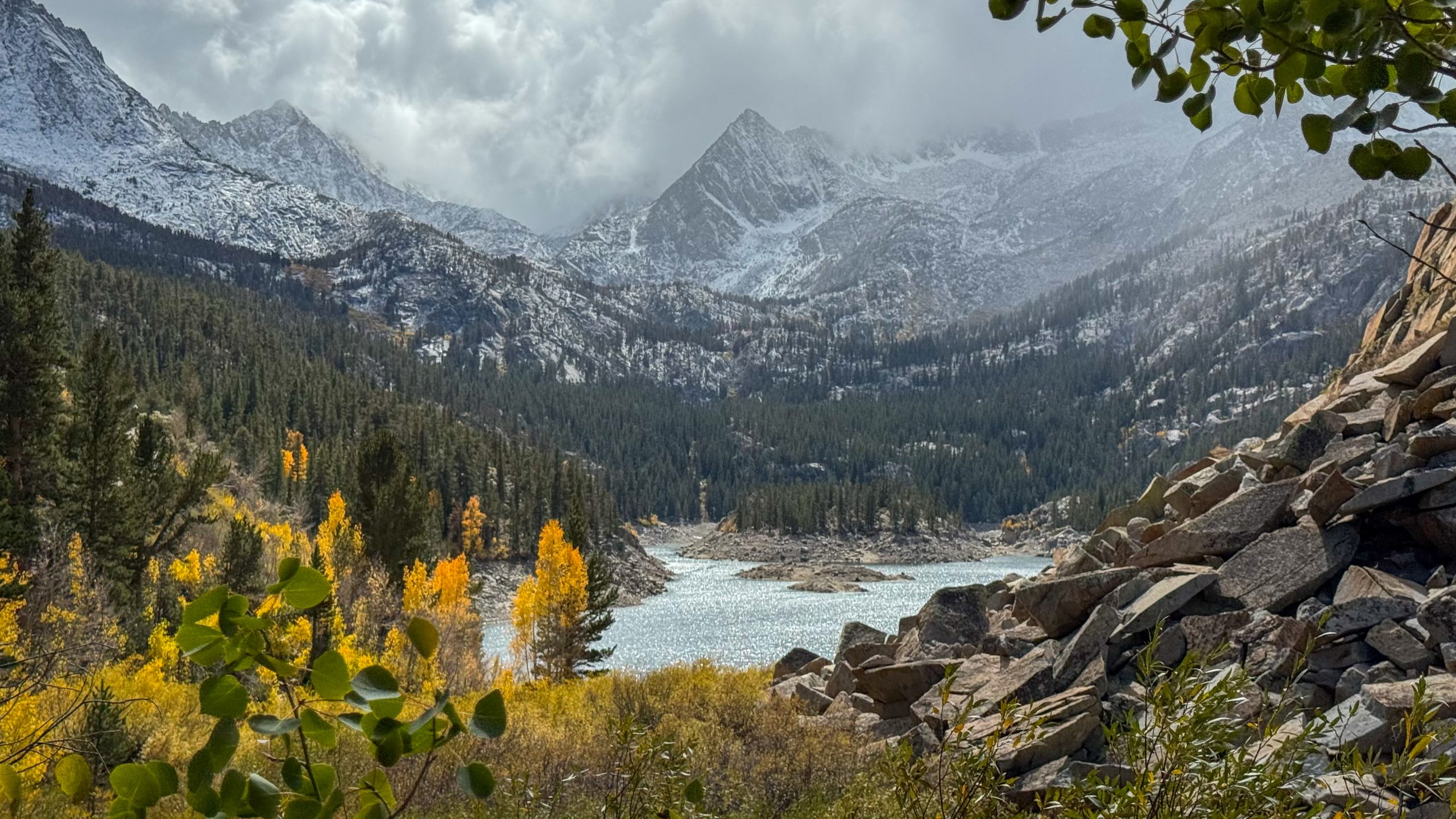
Day 0: Drive to Mammoth Lakes
6 hours of driving – Bay Area → Mammoth Lakes
We kicked off our Eastern Sierra road trip in Mammoth Lakes, which is one of the bigger towns along Highway 395. It’s a great place to start because there are lots of places to stay — everything from cozy Airbnbs to classic hotels. We picked Mammoth Lakes as our launchpad, and it made exploring the mountains so much easier.
If you’re driving from the Bay Area like we did, you’ll probably go through Yosemite. Quick tip: Check the Yosemite website to see if you need a permit for entry.
We drove at night, and even though we had checked Mammoth Lakes’ weather before leaving, the mountains had other plans. Rain and fog hit us hard, making the drive a bit intense. Mountain weather can change fast from west to east, so my advice is to check Yosemite and Eastern Sierra road conditions before you start.
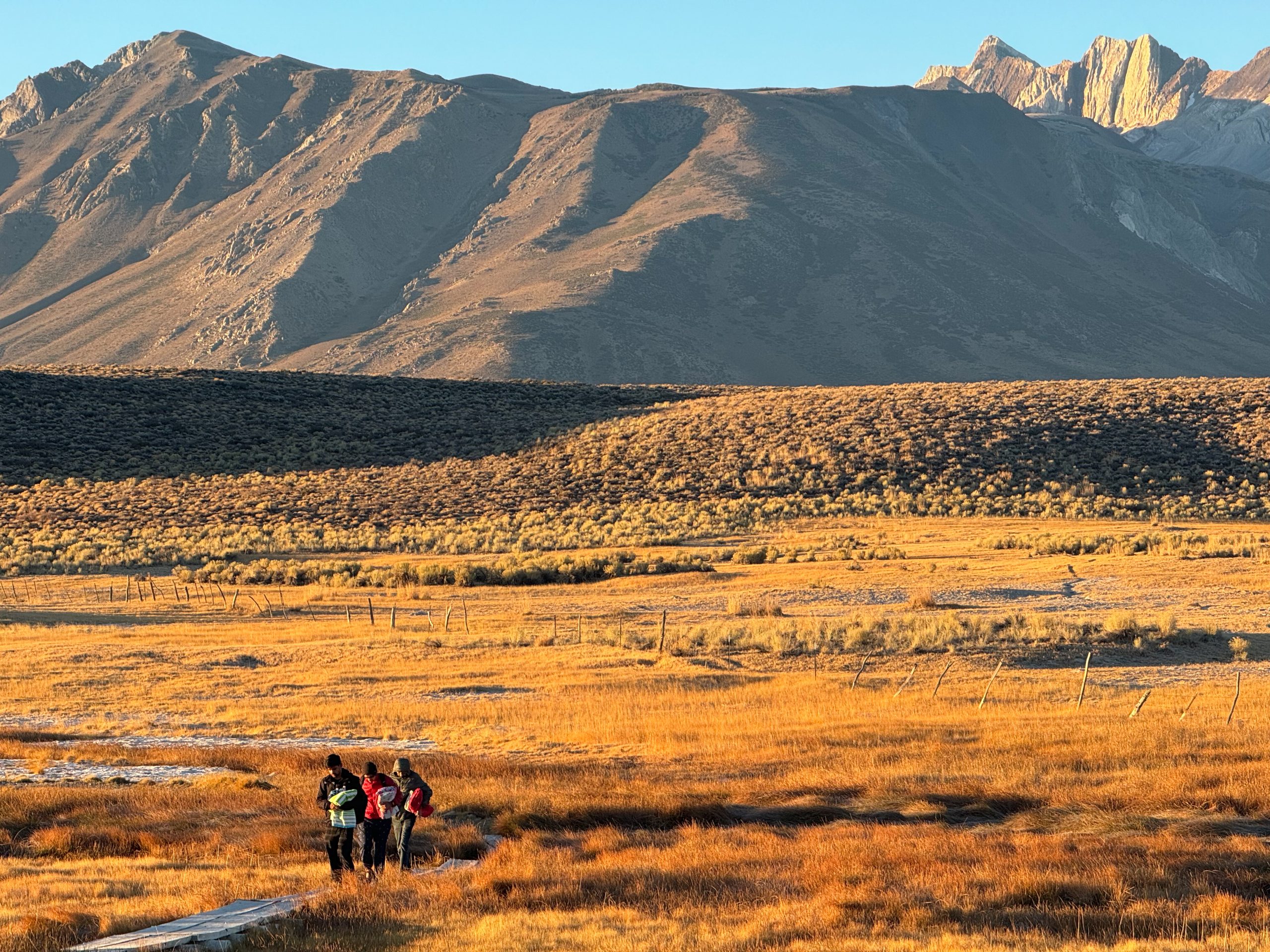
Day 1: Bishop – Alpine Lakes, Yellowstone and the Dead sea
4 hours of driving – Mammoth Lakes → Bishop → Lee Vining → Mammoth Lakes
Our plan for Day 1 – Alpine lakes surrounded by jaw-dropping mountain views, a hot spring site that’s often called California’s “Mini Yellowstone,” and to finish the day at a unique salt lake where the water is even saltier than the ocean! Every stop will make you want to pull over, take a deep breath, admire the unique geology of California and just soak in the scenery.
Lake Sabrina
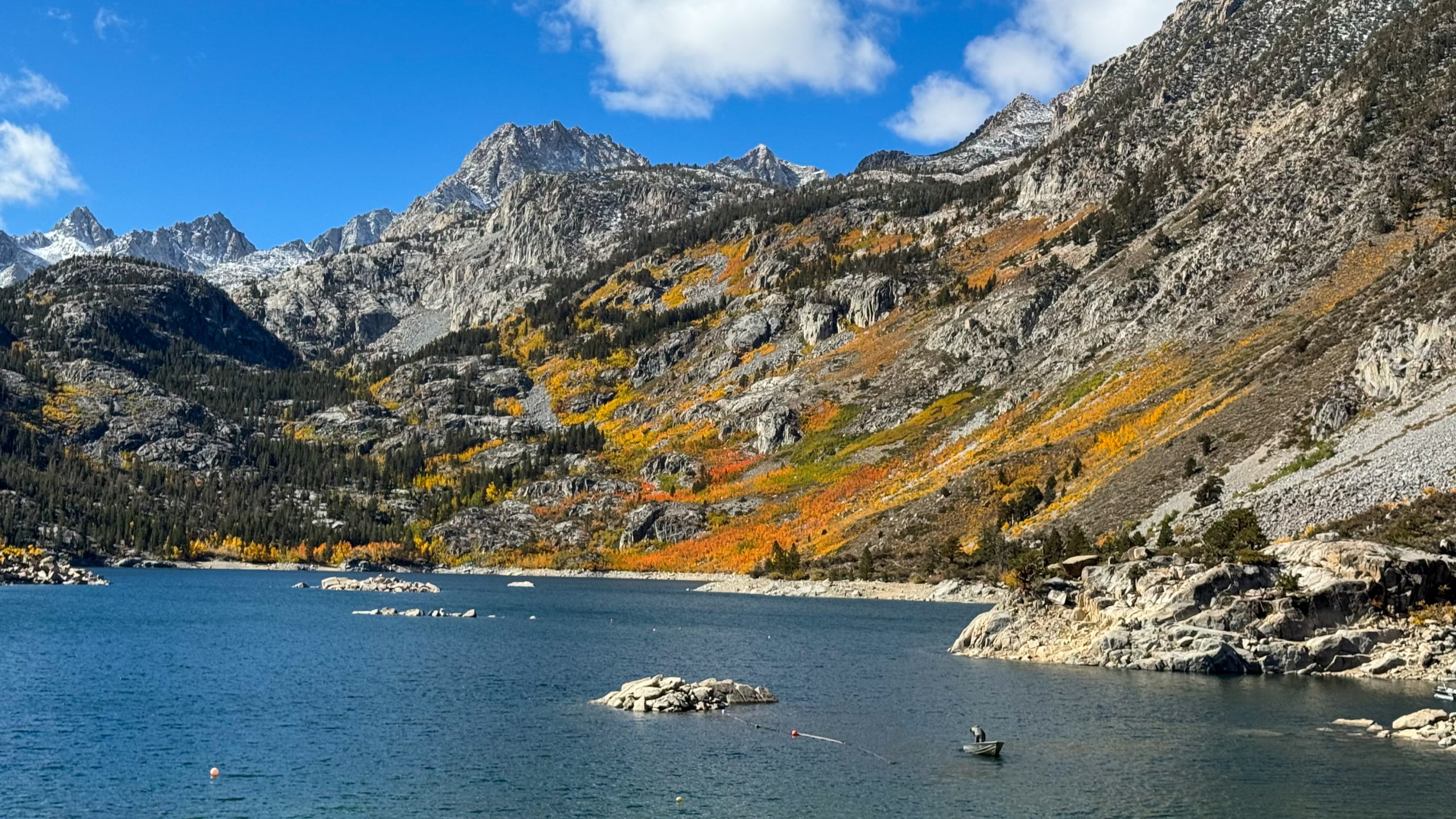
After a hearty breakfast at our Airbnb, we hit the road early and made our way to Lake Sabrina. We were visiting in early October — the perfect time for fall colors at higher elevations — and the timing couldn’t have been better. Even without the golden aspens, though, Lake Sabrina is one of the most beautiful alpine lakes in the Sierras.
The drive up is half the fun. The route is lined with mountain views in every direction, and we found ourselves pulling over more than once just to take photos. By the time we reached the lake, the air was crisp, and the water shimmered under the morning light.
We took a slow walk along the dam, soaking in the colors of the surrounding peaks reflected in the lake’s deep blue waters. Afterward, we warmed up with a cup of hot chocolate at the waterfront café — one of the few lakefront spots you’ll find in the Eastern Sierras. If you’re looking to have breakfast out instead of at your stay, I’d definitely recommend stopping here.
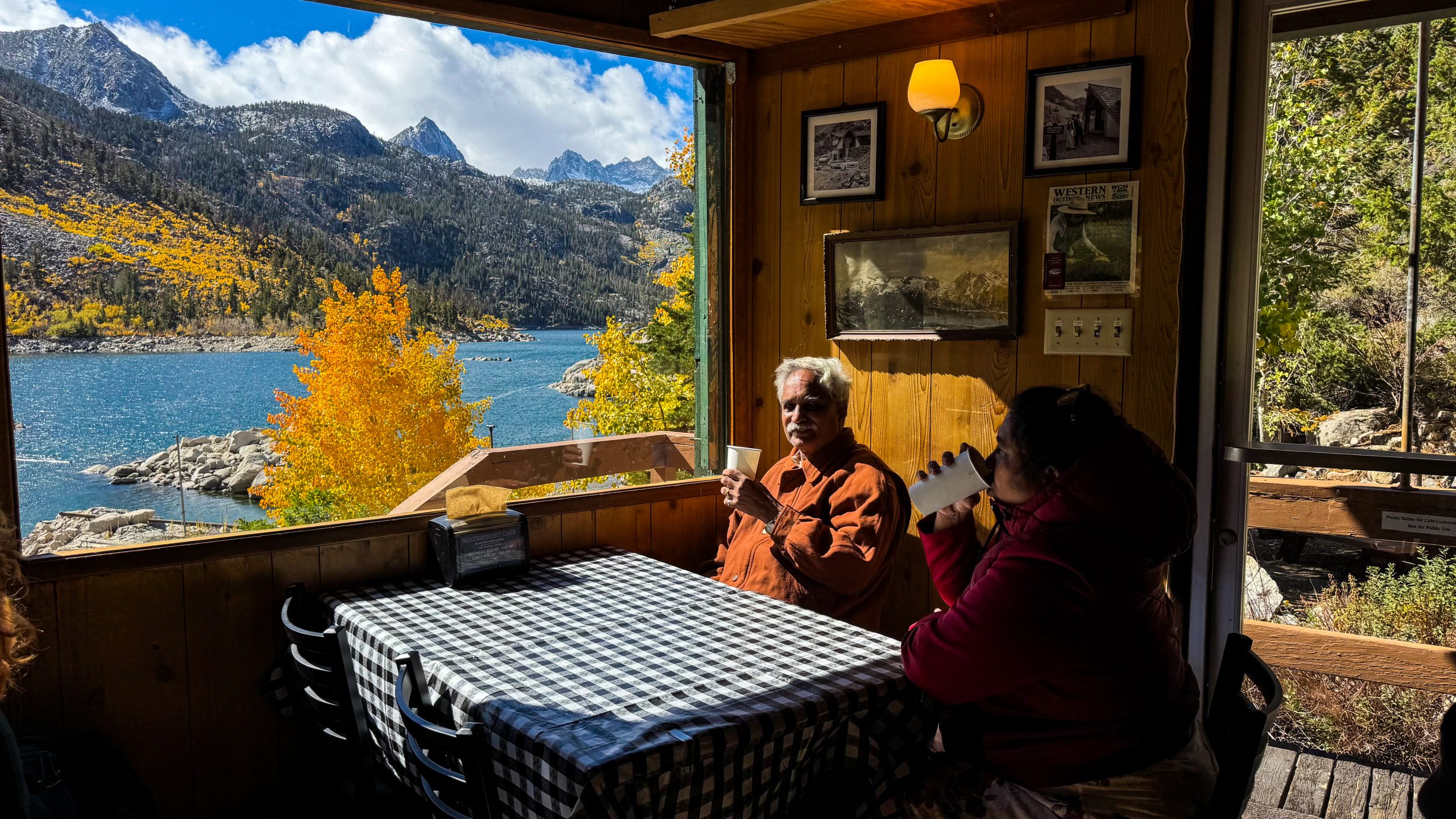
If you have more time, you can rent a boat and spend a few hours out on the water. Rentals are available at the marina, and it’s best to book ahead online to make sure you snag one — they can go fast, especially in fall.
Tip: Check for opening hours of the café and boat rentals before your trip. They usually close for winter and reopen around late spring or early summer, depending on the weather.
North Lake
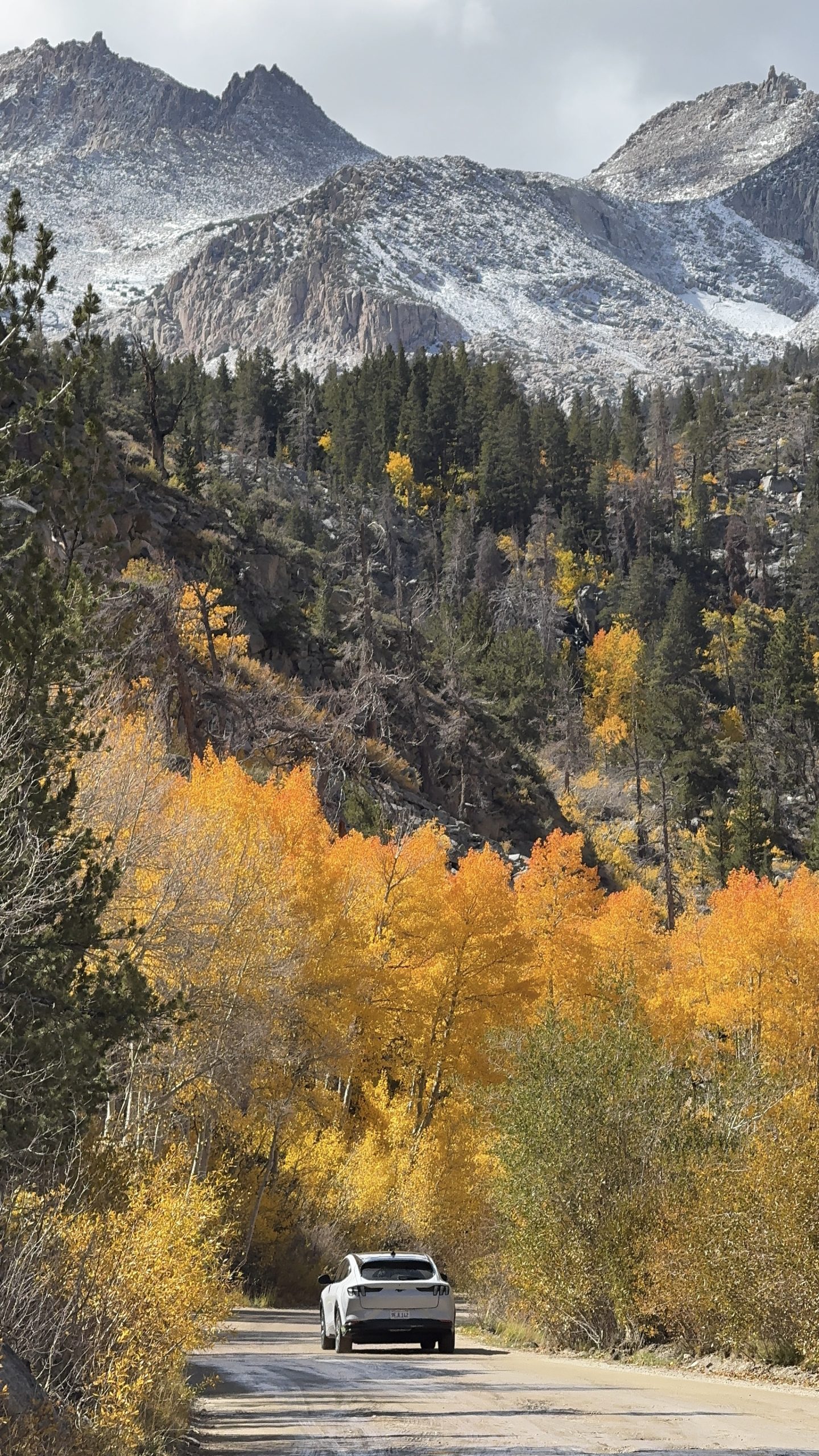
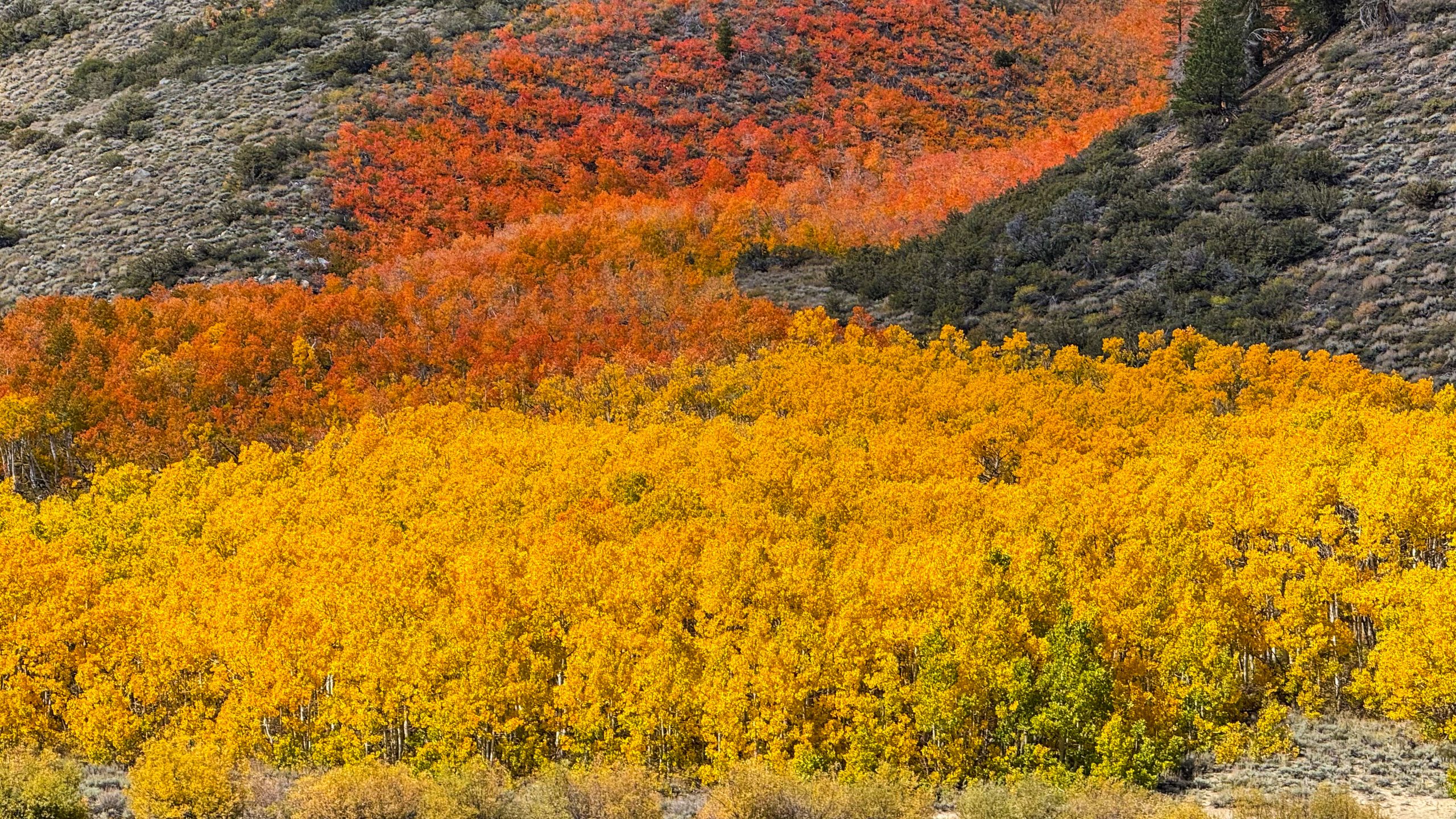
Right next to Lake Sabrina is another gorgeous alpine lake — North Lake. While Sabrina sits on the Middle Fork of Bishop Creek, North Lake is fed by the North Fork, and both are equally stunning in their own way.
North Lake is especially famous for its fiery fall colors — the kind that make you gasp when the aspen leaves turn golden and reflect in the still water. We parked at the day-use area and walked down to the lake to soak in the views. It’s a peaceful spot, surrounded by pines and aspens, perfect for just wandering around or sitting by the shore before heading to your next stop.
South Lake
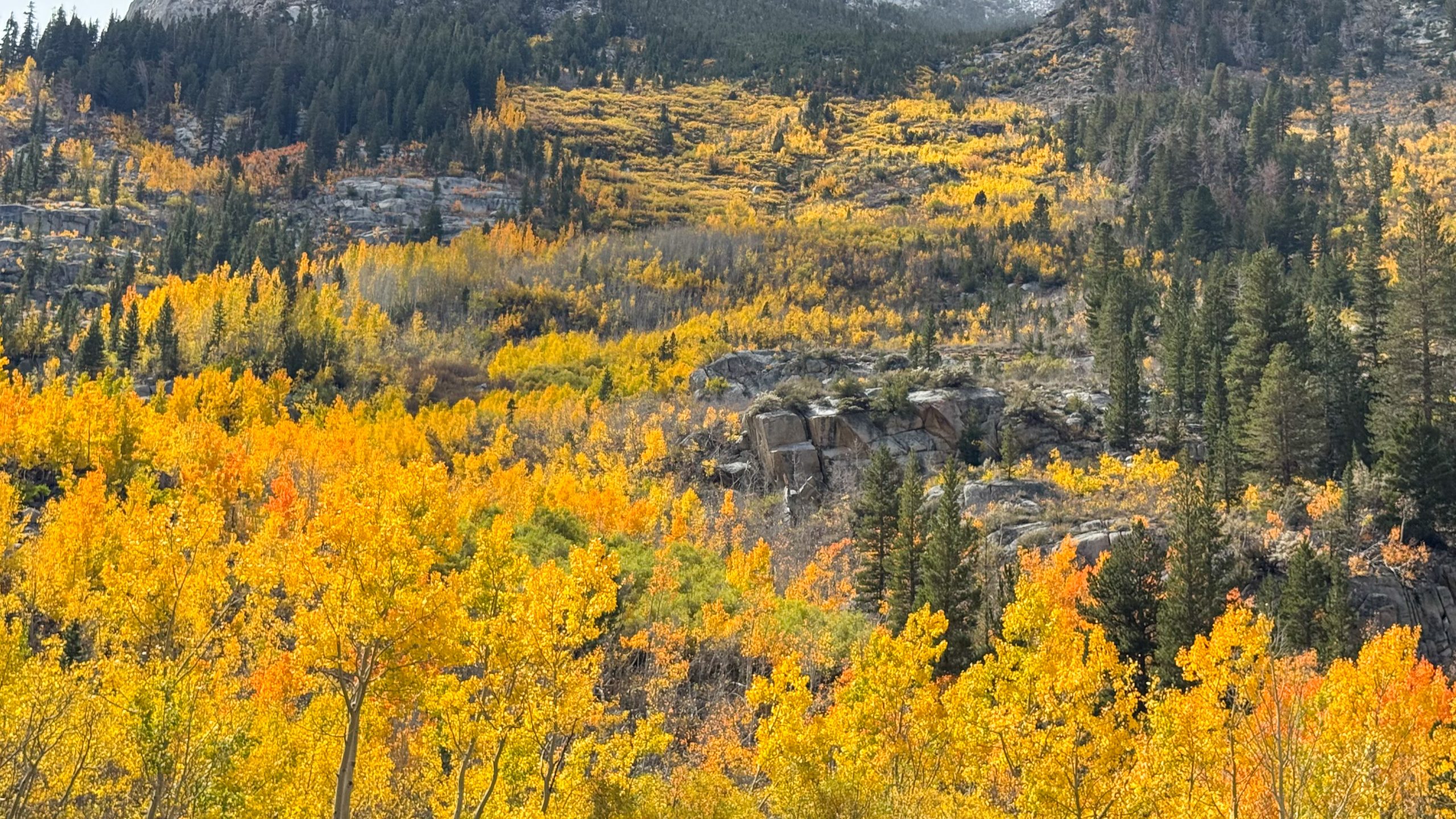
Next, we headed to South Lake, which is fed by the South Fork of Bishop Creek. The drive itself was absolutely stunning — easily one of the most scenic in the area! The road winds through meadows, past the beautiful Misty Falls, and finally opens up to the sparkling South Lake surrounded by towering peaks.
By the time we arrived though, the weather had completely shifted — cold rain started pouring, and clouds rolled in to hide the mountain backdrop. We couldn’t see much, but honestly, it was still beautiful in a moody, mysterious way. It was also a good reminder of how quickly the weather can change in the Sierras, especially at higher elevations.
Hot Creek Geological Site
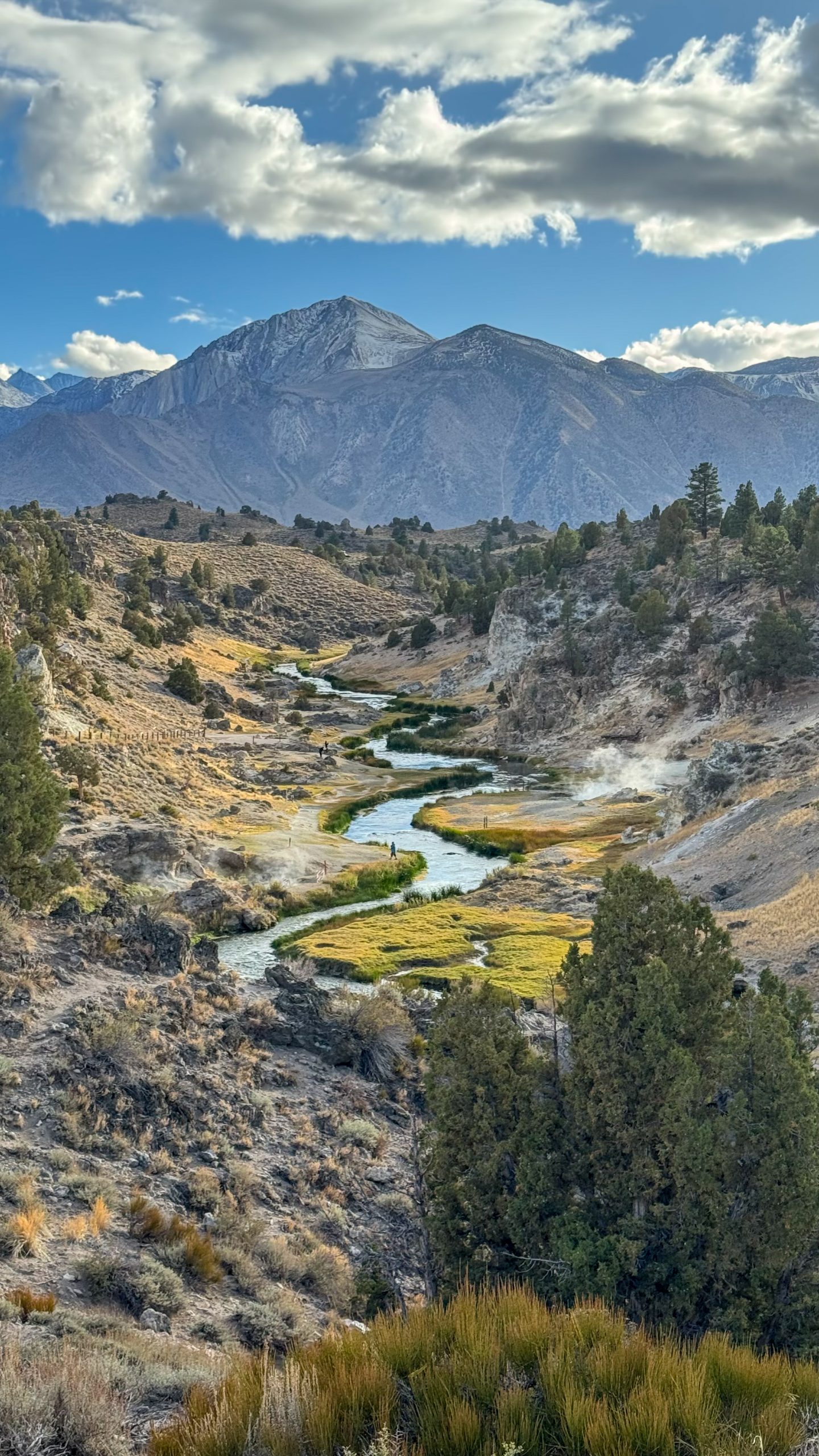
After exploring the lakes, we grabbed a quick lunch in Bishop and headed to a spot I’d been super excited to see — Hot Creek, also known as the “Little Yellowstone of California.”
It’s this crazy-cool geothermal area near Mammoth Lakes where steaming blue pools bubble right out of the ground. The whole place feels otherworldly, with snow-capped mountains in the background and wisps of steam rising from the creek below.
We first stopped at Brees Lookout for the view — totally worth it! Then we took a short walk along the Hot Creek Interpretive Trail to get a closer look at the bubbling springs and the bright mineral colors around them. It honestly felt like stepping into a mini version of Yellowstone.
Mono Lake
After Hot Creek, we had about an hour left before sunset – just enough time to make it to our last stop for the day: Mono Lake! We’d timed it so we could be there for golden hour, and honestly, it’s such a unique spot. The lake is three times saltier than the ocean and is famous for these cool, otherworldly rock formations called tufas that rise right out of the water.
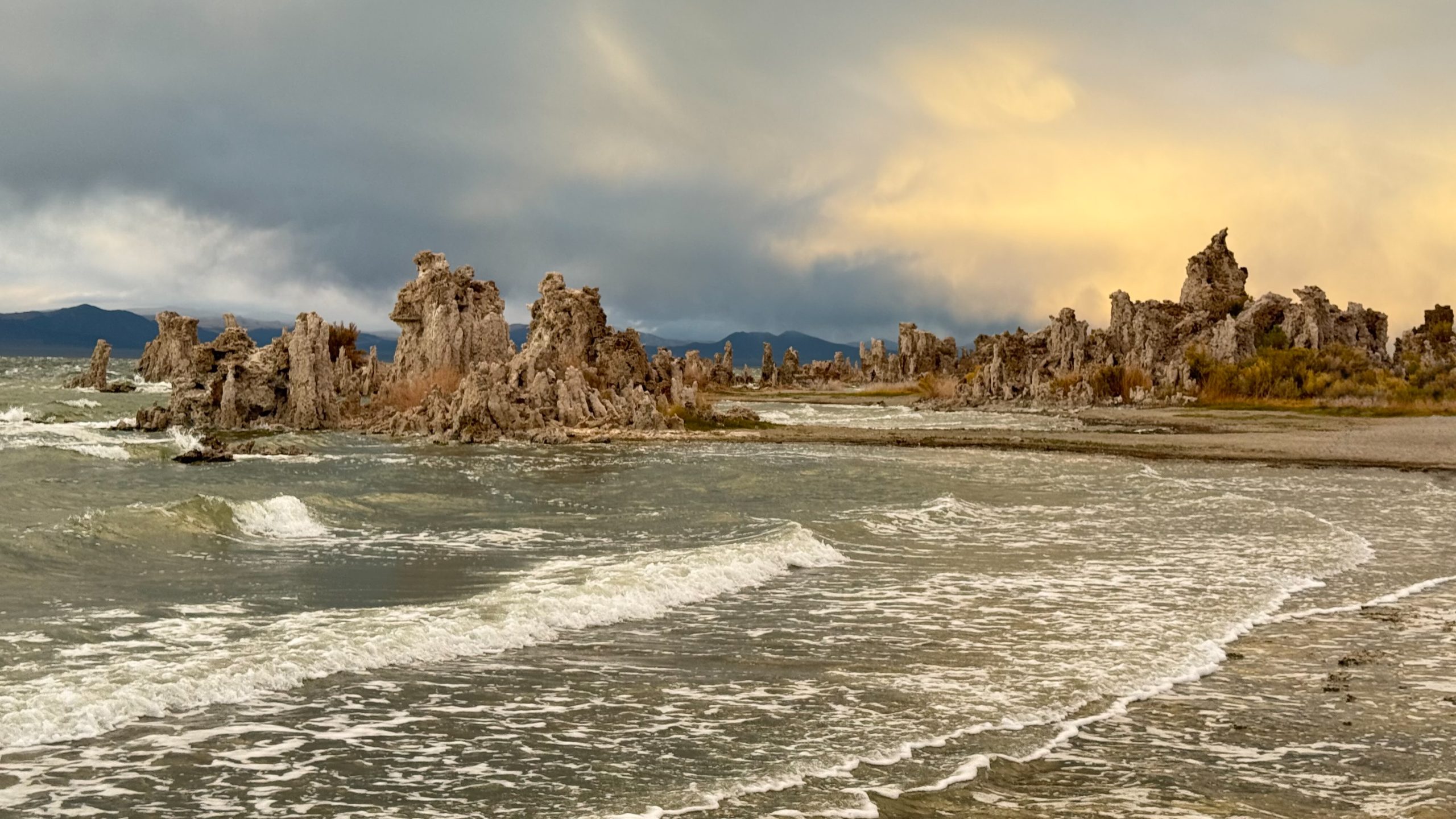
Getting there took a little longer than expected (thanks to the bumpy dirt road), so we ended up missing the golden light by just a few minutes. If you’re planning to go, try to get to the parking lot at least 30–45 minutes before golden hour — that’ll give you enough time to walk the short trail to the lakeshore and catch that dreamy light.
Even without the golden glow, it was still beautiful. The lake was calm, the tufas looked magical in the fading light, and the water reflected the pastel sky. On still evenings, the lake turns into a giant mirror and it’s one of those moments that feels so peaceful, you just want to stand there and soak it all in.
If you’re looking for more hiking, here are alternatives to explore in the area on Day 1.
- McGee Creek
- Big Pine Lakes
- Little Lakes Valley
- Rainbow falls
- Devils Postpile National Monument
Day 2: Mammoth Lakes to Lake Tahoe – Explore Hot Springs and a historical Ghost town
4 hours of driving – Mammoth Lakes → Bodie → Lake Tahoe
Hot Springs at Sunrise
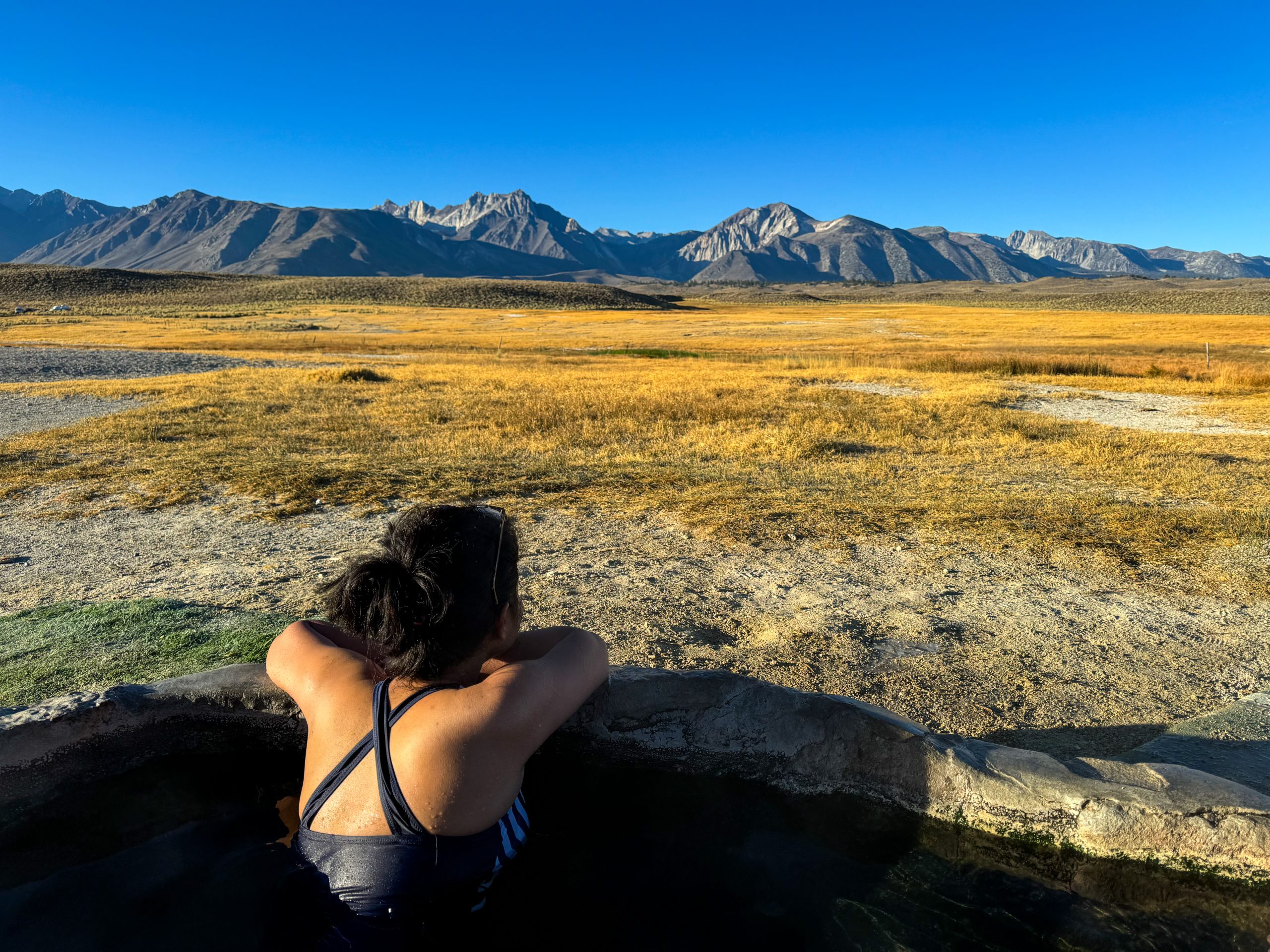
If there’s one thing we never skip when we’re in the Eastern Sierras, it’s a sunrise soak in the hot springs. There’s seriously no better way to start the day — warm, steamy water, crisp mountain air, and the sun slowly lighting up the peaks around you. It feels like magic every single time.
If you’re up for an early morning adventure, head to the hot springs near Mammoth Lakes. They’re tucked away in the wild, close to the Hot Creek geothermal area, and were actually built by someone rerouting the natural hot water flow. You can just drive up, walk a short trail, and hop in — totally free!
There are a few different springs around here, most fitting 4–6 people. Our favorite is Hilltop Hot Springs — it’s small, quiet, and the views are unreal. If you’re traveling with a group, Wild Willy’s Hot Springs is a bit bigger and has multiple pools to choose from.
Just a heads-up: these are clothing-optional, and they do get busy, especially around sunrise. You might have to wait your turn, but honestly, it’s so worth it. Bring a towel, pack your coffee or tea, and soak in.
June Lake Loop
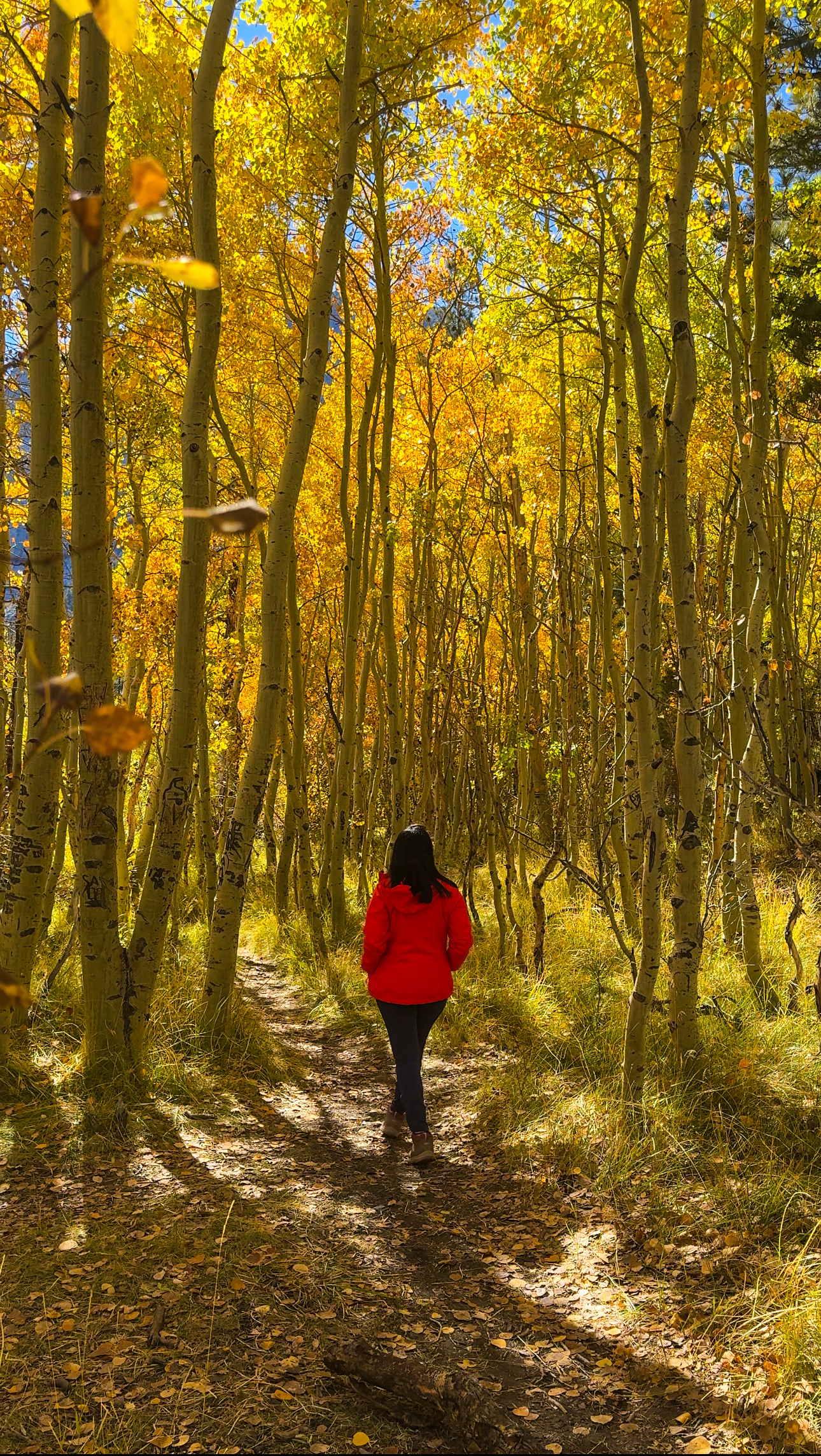
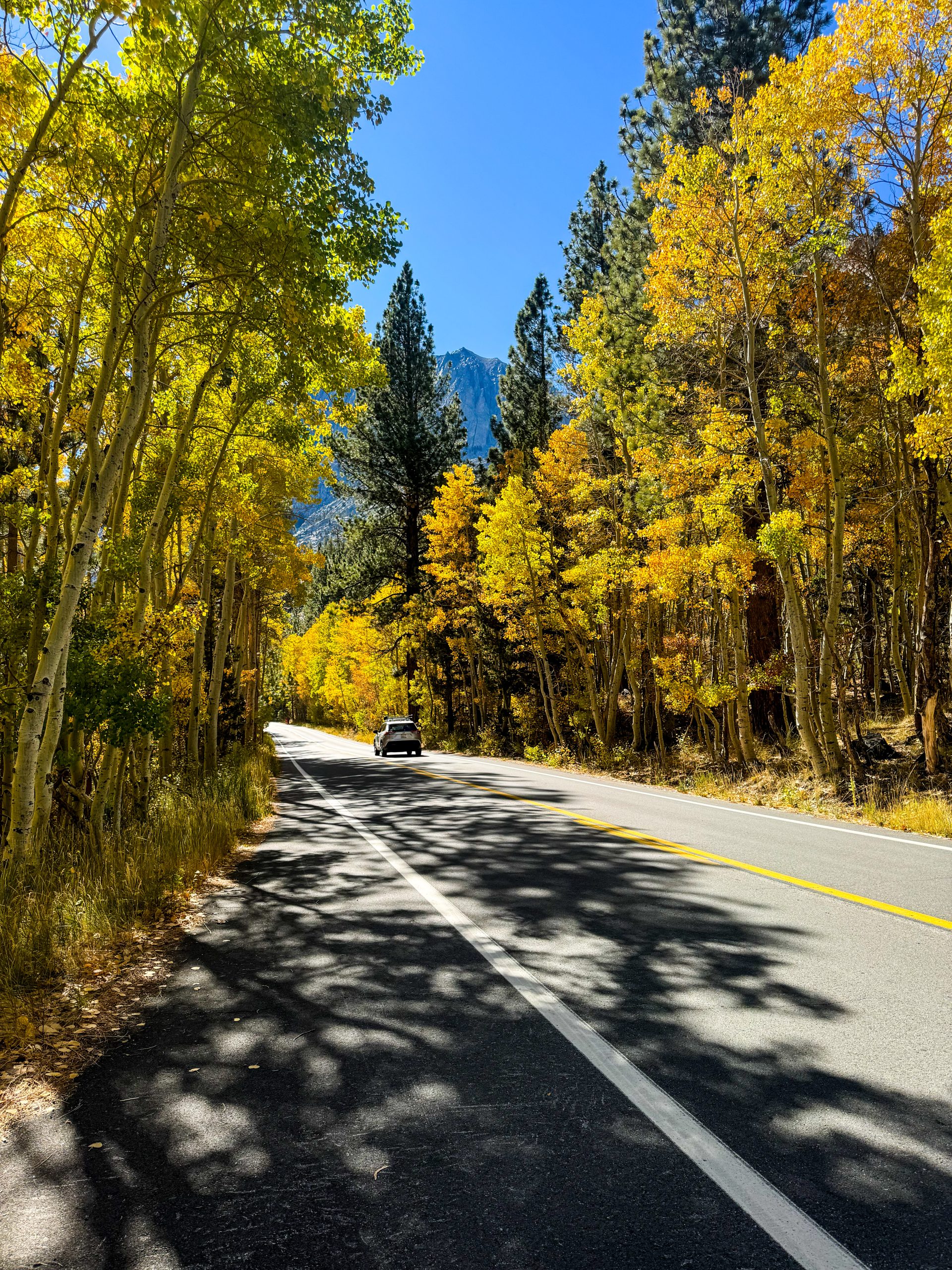
After our morning soak, we headed back to our stay, grabbed breakfast, and packed up for the drive north toward Lake Tahoe — with a few fun stops along the way!
If you’re in the mood for more alpine lakes (and one of the prettiest scenic drives in the area), take the June Lake Loop. The road winds past a handful of lakes and cozy little towns, each one worth a quick stop. Silver Lake is my favorite of the bunch — it’s peaceful, with beautiful reflections of the mountains on calm mornings. Parker Lake has a lovely hike if you feel like stretching your legs, and the town of June Lake itself is perfect if you want to grab a second breakfast or a coffee before getting back on the road.
The June Lake Loop is also one of the best spots in the Eastern Sierras for fall colors — bright yellows and oranges line the road, making every turn feel like a postcard.
Virginia Lakes
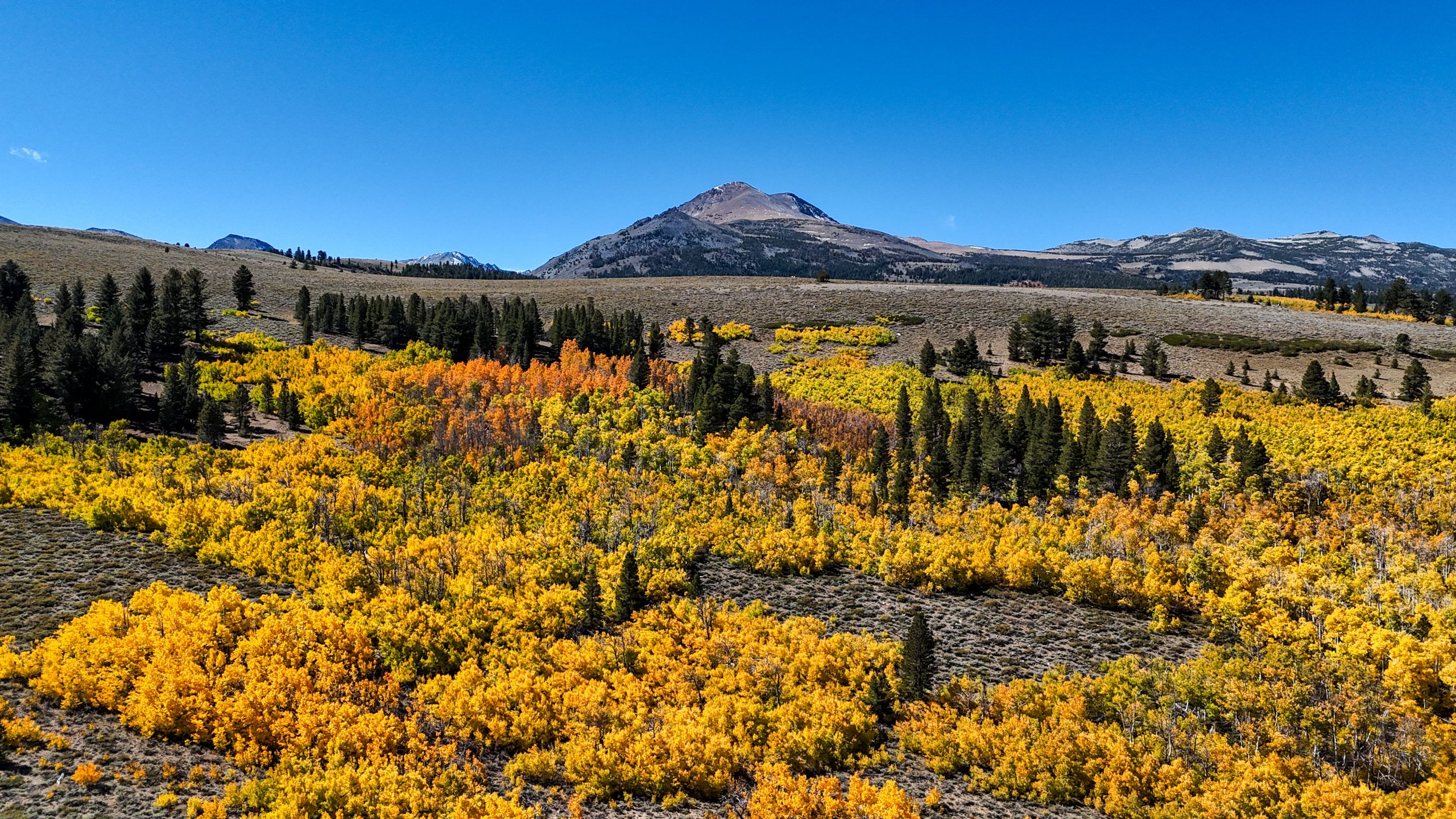
Then, we headed north to Virginia Lakes — such a beautiful spot and one of my favorites in the area. The drive up is stunning, especially in fall when the aspen groves turn bright gold. The Virginia Lakes Trail takes you past a bunch of sparkling alpine lakes, and you can make it as short or long as you like. Perfect for a quick walk or a peaceful picnic by the water.
Conway Summit
Next up was Conway Summit, a picturesque pullout right along the highway. It’s one of those spots that makes you want to slam on the brakes and take a few extra minutes — the views of the surrounding mountains and meadows are incredible.
Photographers love this spot, and it’s easy to see why. In the fall, the aspen and other trees light up with brilliant yellows and oranges, making the sweeping mountain vistas even more magical. Even if you’re just passing through, it’s worth a short stop to stretch your legs and take in the scenery.
Bodie State Historic Park
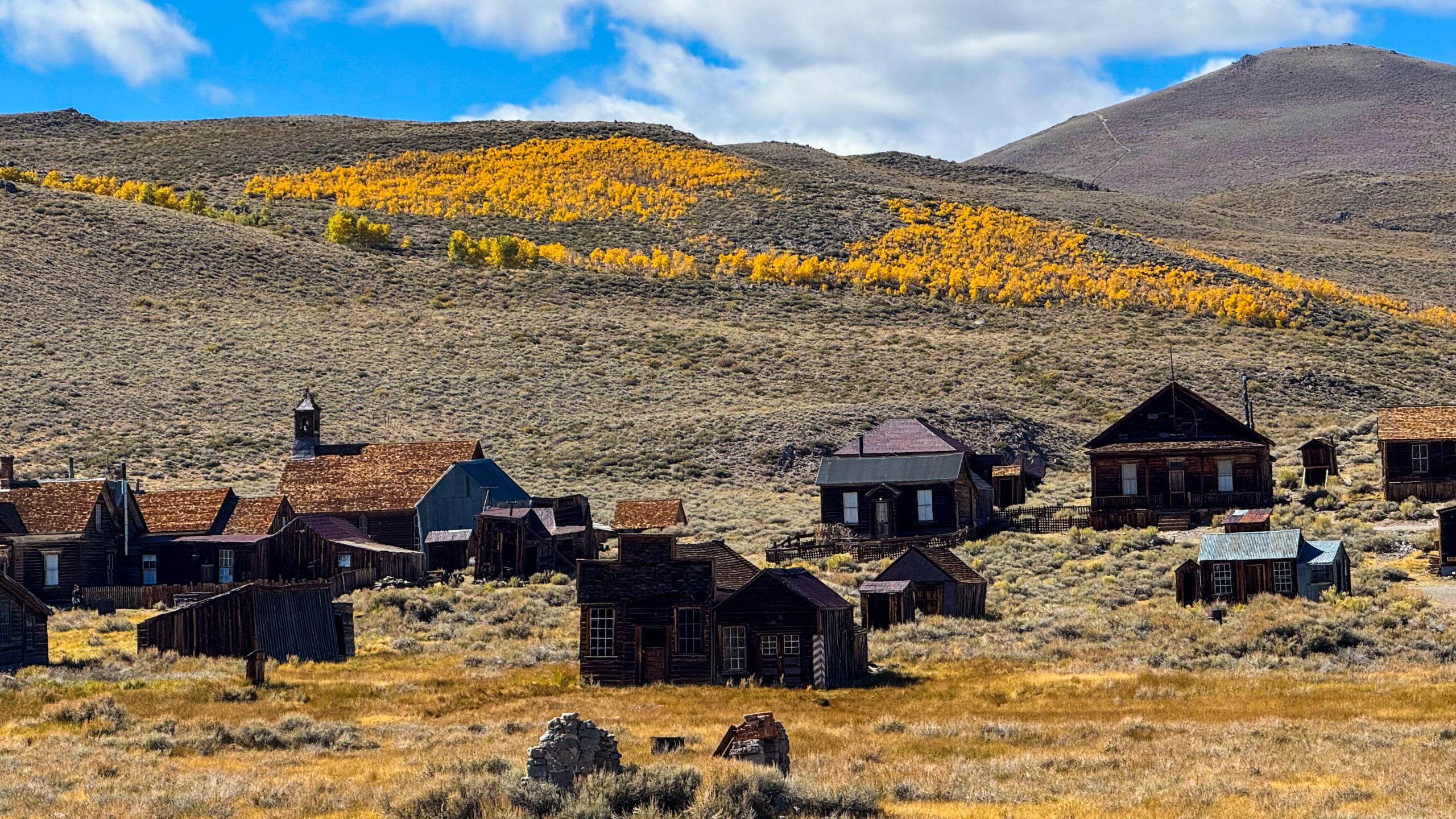
Next, we visited Bodie State Historic Park, our first time seeing a gold-mining ghost town in person. Stepping into Bodie felt like walking onto the set of a Wild West movie. The town is officially a State Historic Park, preserved in “arrested decay” — buildings are left as they were but maintained enough to keep them from collapsing entirely.
We wandered the streets, peeked into abandoned homes and shops filled with old furniture, and passed by an old gold mine. It’s fascinating to imagine what life was like here during Bodie’s heyday in the late 1800s, when it was a bustling town with thousands of residents.
The drive to Bodie is just as scenic as the town itself — winding through high desert landscapes and mountains. Heads up: the last stretch of road to the park is dirt, so take it slow, especially if you’re in a regular sedan.
Tip: There are no cafes, gas stations, or stores once you turn off for Bodie, so make sure to fill up your tank and pack water and snacks before you go.
Bridgeport
After exploring Bodie, we drove into Bridgeport for lunch. This charming small town is a laid-back, old-west vibe that’s perfect for a quick break. It’s a great place to stretch your legs, grab a bite, and refuel before continuing your drive. If you have a sweet tooth, don’t miss the soft serve at Jolly Kone — it’s a local favorite and the perfect little treat to enjoy while wandering the town.
Dinner at South Lake Tahoe
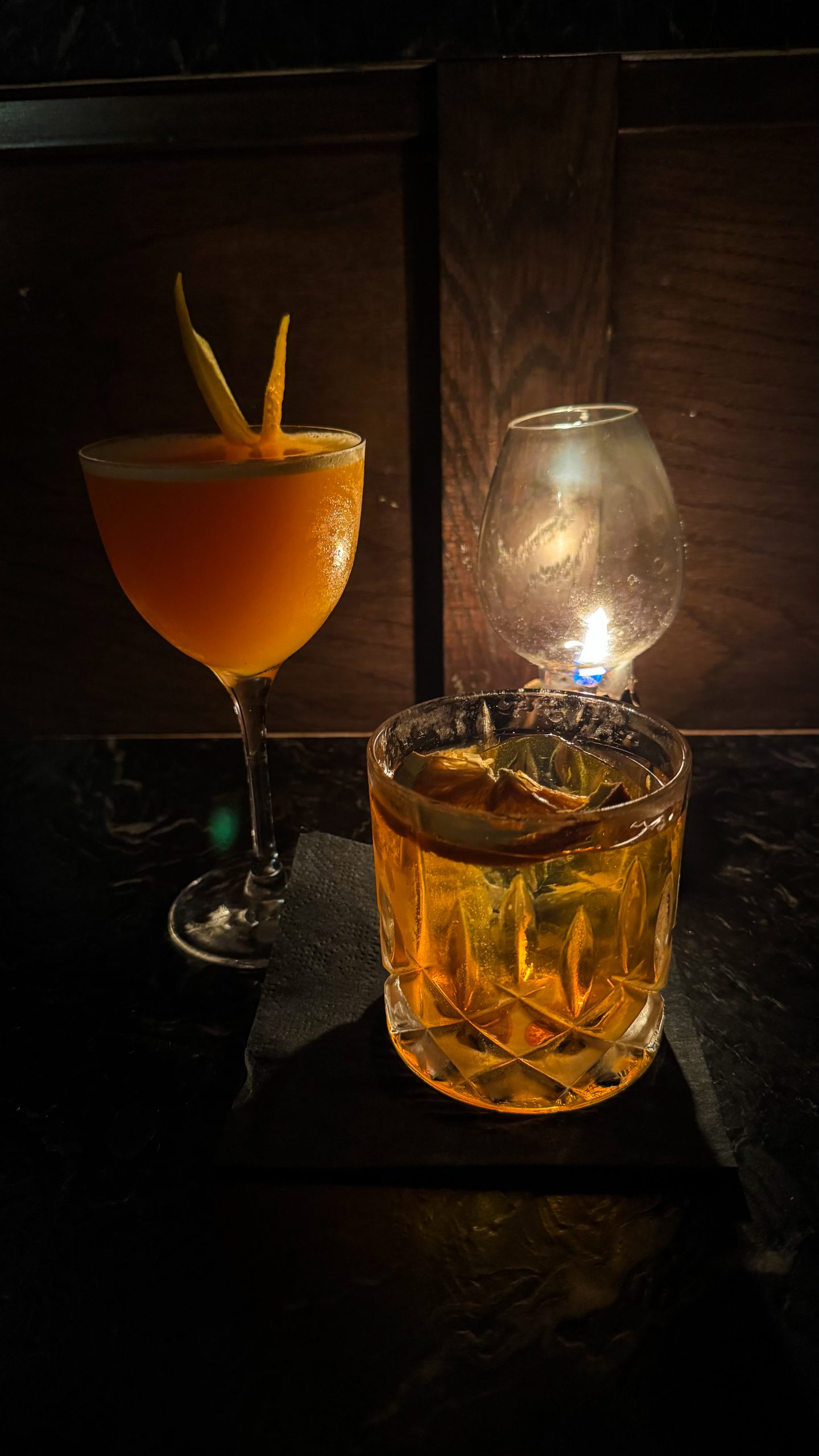
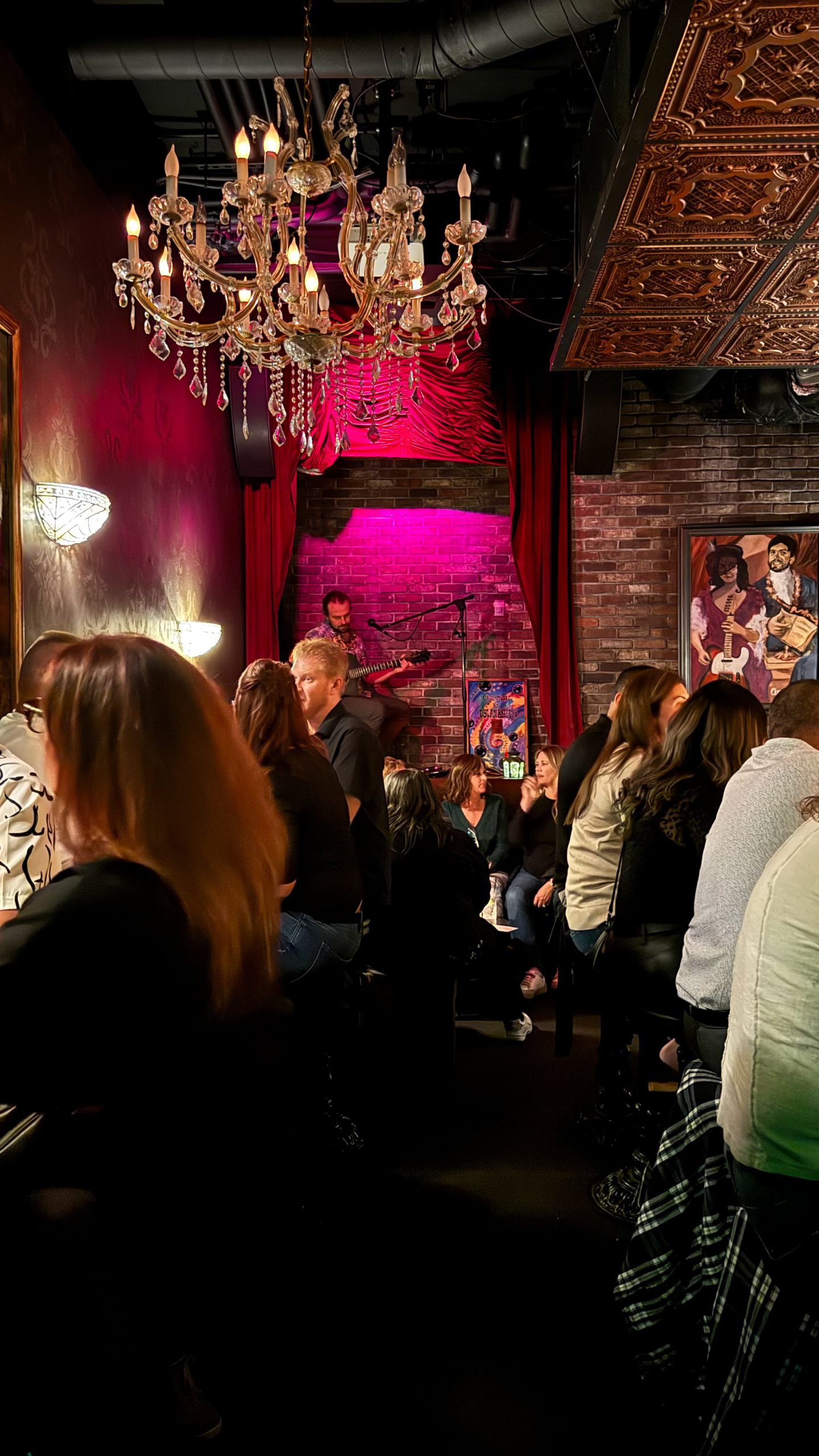
We arrived in South Lake Tahoe just before sunset, checked into our hotel, and rested for a bit before heading out for dinner. If you’re into speakeasy vibes, don’t miss The Cooler inside California Burger Company. It’s a small, cozy spot, so you might have to wait for a table, but the ambiance is totally worth it.
For dinner, we grabbed a slice at Base Camp Pizza Co, which is just nearby. Delicious pizza and the perfect way to end a day full of exploring.
Other places explore on Day 2 if you have time
- Lake Crowley
- Convict Lake
- Sagehen Summit – this is a must-go if you go late September for the fall colors.
Day 3: Lake Tahoe – Water so blue, you can’t tell when the sky starts
5 hours of driving – Lake Tahoe → Bay Area
We had about 3–4 hours to explore South Lake Tahoe before starting our drive back home. Traffic leaving Tahoe can get pretty bad, so we planned to hit the road around noon to get a head start.
Pope Beach
Our first stop was Pope Beach — and to our surprise, we had the place completely to ourselves! The sandy shore was quiet, the water calm, and there was a gentle breeze. I’ve never seen a Tahoe beach that empty before. Fall really is the best time to visit if you want that peaceful, crowd-free experience.
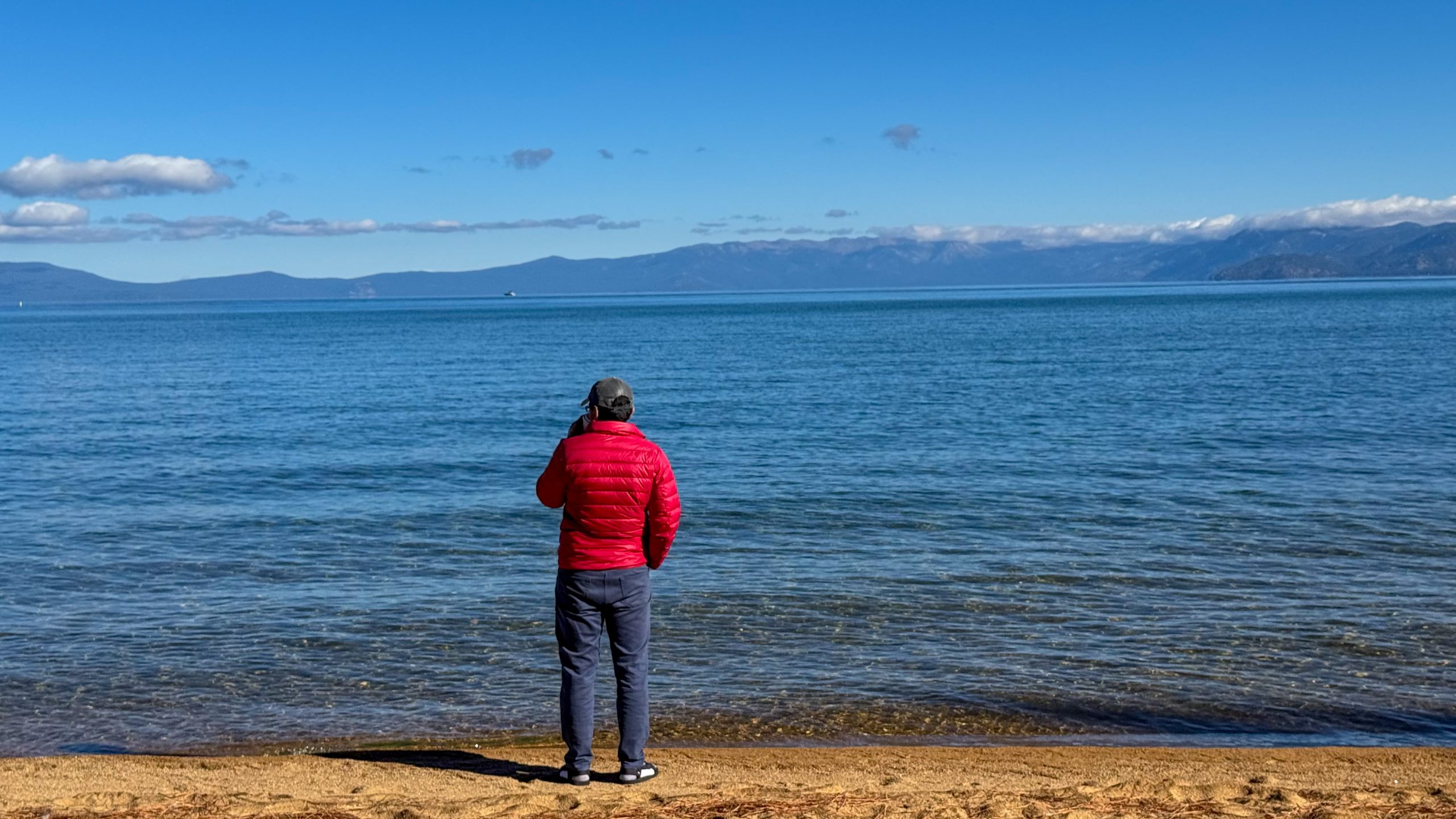
Emerald Bay State Park
Next, we drove up to Emerald Bay State Park to soak in the iconic views from the vista points. It’s one of those spots that never gets old, no matter how many times you’ve been. The turquoise water, the little island in the middle, the surrounding pines, it’s just stunning every time.
Other places to explore if you have more time
- Vikingsholm
- Glen Alpine Falls
- Fallen Leaf Lake
- Eagle Lake trail via Eagle Falls
After soaking in those last lake views at Emerald Bay, we grabbed a quick bite and started our drive back home, tired, happy, and full of memories from another incredible Eastern Sierra trip. There’s just something about this region that keeps pulling us back. Maybe it’s the mix of wild landscapes, cozy small towns, or the feeling of being surrounded by nature everywhere you look.
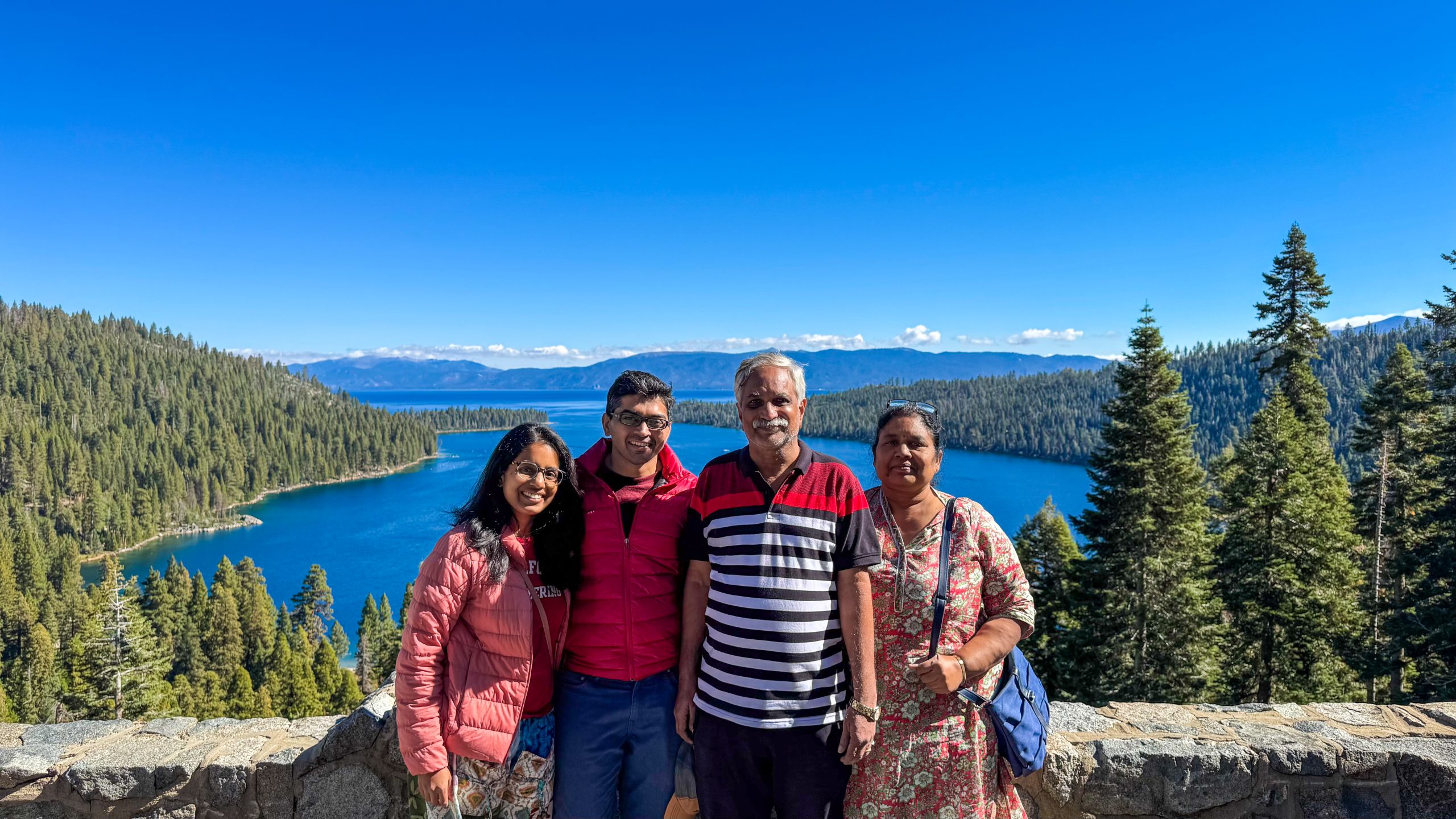
Every visit reminds us why the Eastern Sierras are one of California’s best-kept secrets and this road trip was no exception.
If you enjoyed this blog post, Subscribe to the blog to get free adventures right to your inbox. Or follow us on IG (@weekendwanderersinc) for more recommendations and adventures.


